Twenty years ago, 99% of business owners would stare blankly into space if you mentioned the acronym SaaS.
These days it’s almost impossible to run a business without using at least one of the many SaaS products available on the market.
In 2019, companies with 0-50 employees used, on average, 40 SaaS products. That’s almost as many as many SaaS subscriptions as employees.
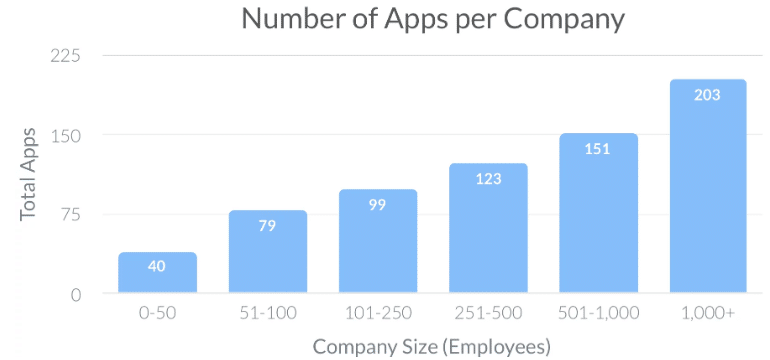
And this isn’t a bad thing. If you’re stuck using only a few, your company probably isn’t running at full efficiency.
In this post, we take a closer look at what SaaS is and how it can help your business. We will also deep dive into 40+ SaaS products we use to grow our own company.
Ready to start? Let’s rock!
SaaS Definition: What Is SaaS?
The acronym SaaS stands for software as a service. It is a software distribution method that typically involves paying on a subscription model for a product, tool, or service.
(Suggested reading: make sure to read our in-depth guide on SaaS marketing).
In most cases, SaaS products are now hosted in the cloud and are accessible from anywhere via your web browser or mobile device.
In the past, software companies relied on a licensing model to sell their digital products and make money.
The difference between a licensed software product and SaaS is that you install and run traditional software on your own computer or server. With SaaS, the company typically hosts and manages the software solution for you.
So instead of just buying the code, you pay for the service of hosting, updating, and maintaining the software, servers, and databases as well.
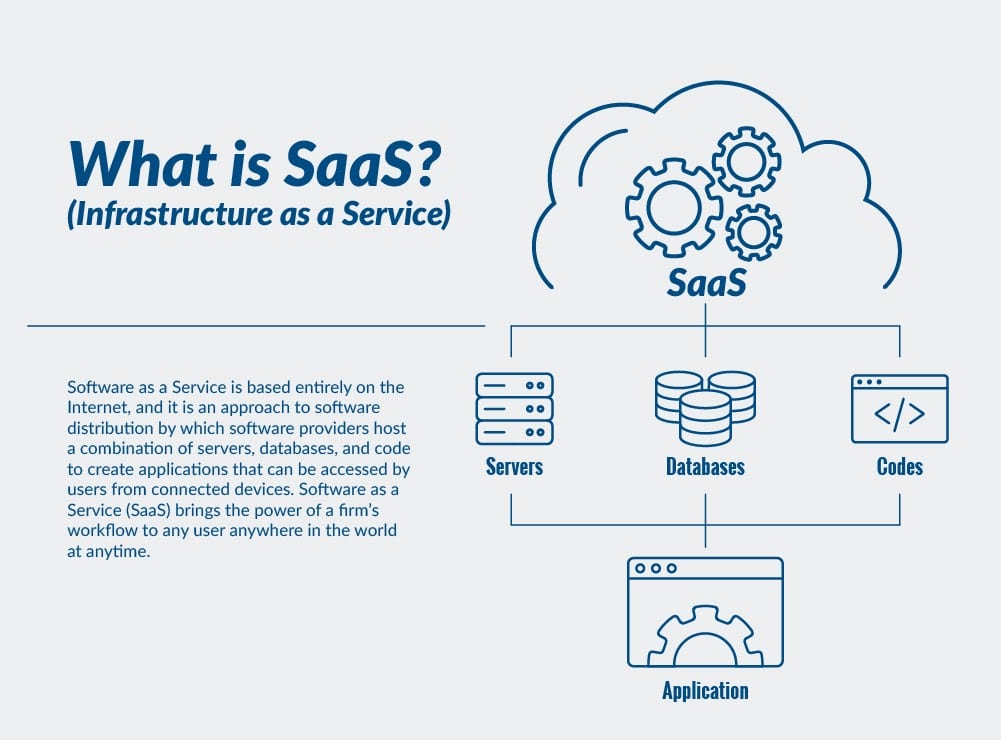
SaaS vs PaaS vs IaaS
You might be confused about what all the different acronyms in the SaaS industry stand for.
In this section, we will quickly cover the differences between SaaS, PaaS, and IaaS.
Software as a Service (SaaS)
SaaS, as we mentioned above, stands for software as a service. It typically is a hosted software solution that helps businesses or individuals improve their productivity.
What Are Some Examples of SaaS?
SaaS products are typically software solutions that help businesses or individuals solve specific problems. Salesforce helps companies keep track of customers and prospects and understand them better.
Dropbox helps businesses and individuals keep files safely in the cloud and share them.
More Examples: BigCommerce, Google Workspace, HubSpot, Microsoft Office 365, Shopify, WooCommerce, Slack, Zendesk, Zoom.
Platform as a Service (PaaS)
PaaS is short for platform as a service. Rather than software that directly solves business problems, PaaS solutions focus on offering a development platform for their service. These tools help businesses instance, test, and deploy original code and forks of their software.
Examples: AWS Elastic Beanstalk, Heroku, OpenShift, Magento Commerce Cloud.
Infrastructure as a Service (IaaS)
Infrastructure as a service or IaaS is almost synonymous with cloud computing platforms. These solutions allow businesses to deploy, host, and scale web-based applications. Virtual machines enable almost limitless scaling of server capacity.
Rather than a set monthly fee, the pricing model is often pay-as-you-go.
Examples: Amazon Web Services (AWS), Google Cloud, Microsoft Azure, Rackspace.
B2B vs B2C SaaS Products
The final differentiator between these cloud services is their intended target audience. The functionality, design, and even pricing model is vastly different between B2B and B2C products.
What Is a B2B SaaS Product?
B2B or business-to-business SaaS products are hosted software solutions designed to solve business problems.
Think software solutions like CRM, ecommerce platforms, analytics, and more.
What Is a B2C SaaS Product?
B2C or business-to-consumer SaaS products are cloud-based software solutions designed to solve individual problems.
Think online editors, file sharing, website builders, streaming services, and even social media networks.
For an in-depth look at the differences, make sure to read our B2B vs B2C marketing guide.
Horizontal SaaS vs Vertical Saas
SaaS applications don’t just fall into categories based on whether or not their target market is consumers or businesses.
There are also categories based on how companies design their products and what needs they serve.
Horizontal SaaS
The Horizontal SaaS model includes SaaS solutions that serve the business needs of a wide variety of companies.
Instead of focusing on solving the specific business problems of one particular industry, they offer a broader range of tools that serve companies across industries and borders.
Vendors that succeed in this SaaS market are typically more mature companies. It’s almost a necessity to start a strong foothold in multiple industries and verticals.
Examples:
- Salesforce offers CRM and workflow automation tools suitable for virtually any industry.
- QuickBooks offers accounting, bookkeeping, and invoicing tools mostly to online professionals but not exclusively. We also use their service here at Kinsta (more on that below).
Most successful horizontal SaaS vendors have “crossed the chasm” and managed to win a significant portion of the mass market.
Vertical SaaS
Vertical SaaS refers to software solutions specifically designed for a specific industry need.
Instead of general solutions that companies need to integrate and customize, users can plug-and-play with little up-front effort. That’s possible because the software doesn’t have to be general enough for mass-market use.
Examples:
- Opentable is a table booking system tailored to restaurants.
- Guidewire is an insurance platform designed explicitly for property insurance companies.
Some SaaS companies start by providing a vertical solution and expand to become horizontal at a later stage or launch new related products/services as cross-sells and upsells.
Now that you know a bit more about SaaS products, how would you like to know which ones we’re using to power up our company?
Here they are…
40+ of Our Favorite SaaS Products
If you are a brand new startup, we don’t recommend going out and immediately subscribing to all the tools below. We are merely highlighting SaaS products that help us be more effective as a company.
A lot of entrepreneurs have had great success bootstrapping their companies from the ground up and adding additional tools as they grow their revenue.
That is what we did here at Kinsta. Tools and services like these can add up fast, so do your research, be smart, and determine which ones you might need first to help you accomplish your priority goals more quickly.
Accepting Payments
These are the SaaS products we use to accept and handle payments online.
1. Stripe
The very first thing most companies have to decide is what payment processor they are going to use to accept payments from their customers. There a lot out there to choose from, such as PayPal, Stripe, Braintree, etc.
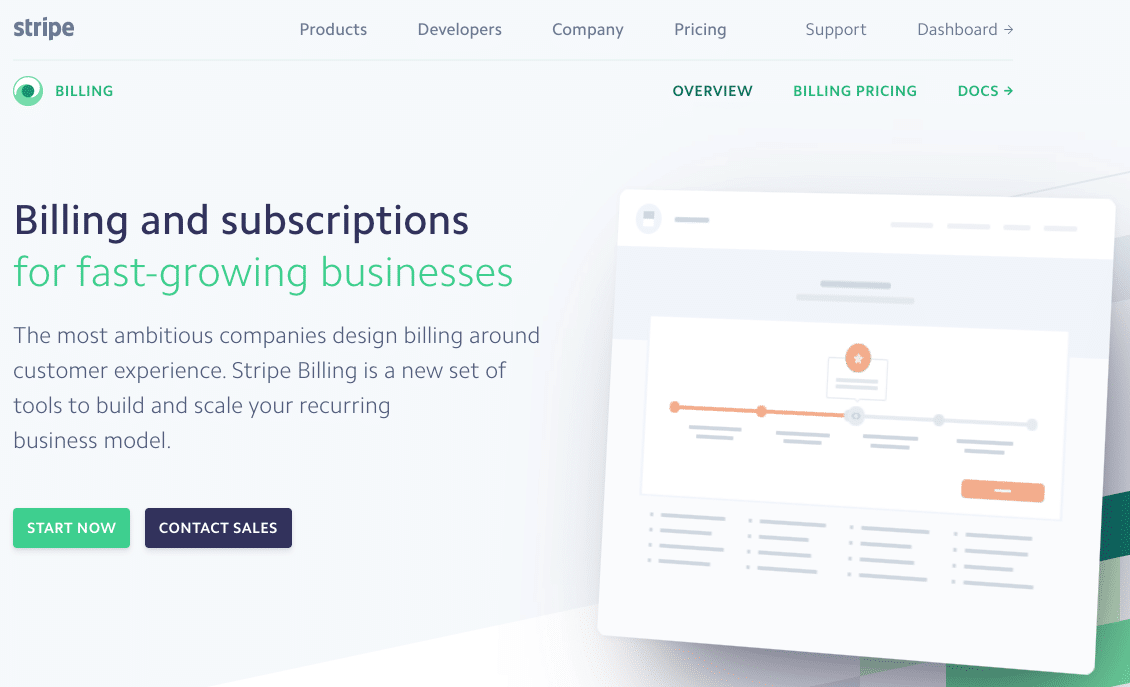
Here at Kinsta, we decided to go with Stripe because it is very developer-friendly, has low credit card processing transaction fees, and was easy to integrate into our backend dashboard.
Those of you who have followed us for a while know that our Stripe relationship had a rocky start back in 2014. But all companies make mistakes at some point, and Stripe did everything in its power to resolve the situation we encountered.
Fast forward two years, and we can say we still love Stripe! We think it is the best thing that has happened to online payments since PayPal, and are happy to call them a business partner. The takeaway is that customer support is more important than ever!
Recommended for further reading: How to Prevent and Reduce Credit Card Fraud by 98% Using Stripe Radar
2. PayPal

PayPal is another leading tool for handling, sending, and accepting payments online for businesses and individuals.
You can transfer money, create and send invoices, create recurring payment subscriptions, and more.
At Kinsta, we mainly use Paypal for handling affiliate payouts, not for handling recurring customer payments or invoices.
Suggested reading: PayPal vs Stripe, which payment gateway should you use?
Tracking Revenue
Other than Stripe’s internal tools, these are the SaaS products we use to stay on top of our revenue.
3. Baremetrics
Baremetrics is just like its brand name says: it is all about the metrics! It offers analytics and insights for payment processors such as Braintree, Stripe, and Recurly.
When it comes to choosing some SaaS products for your business, this is a must-have.
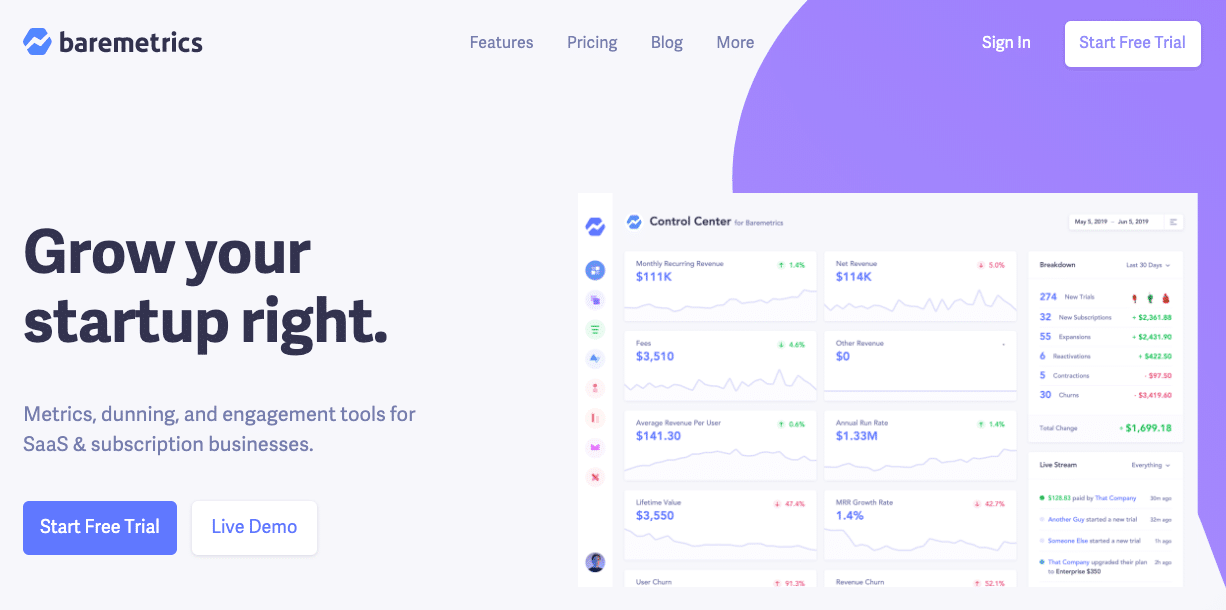
Why do you need Baremetrics? Well, it simplifies the process of understanding your business’s revenue income stream and helps you make data-driven decisions.
You can instantly see juicy bits of information such as monthly recurring revenue, average revenue per user, refunds, upgrades, lifetime customer values, user churn, and probably the two most important ones: your net income and revenue growth rate.
You could calculate all this information yourself in a spreadsheet, but then immediately, you should be weighing the cost of your time for doing this.
Check out its dashboard demo (seen below). We love using Baremetrics at Kinsta, along with the Stripe integration. It gives us an instant overview of our business performance.
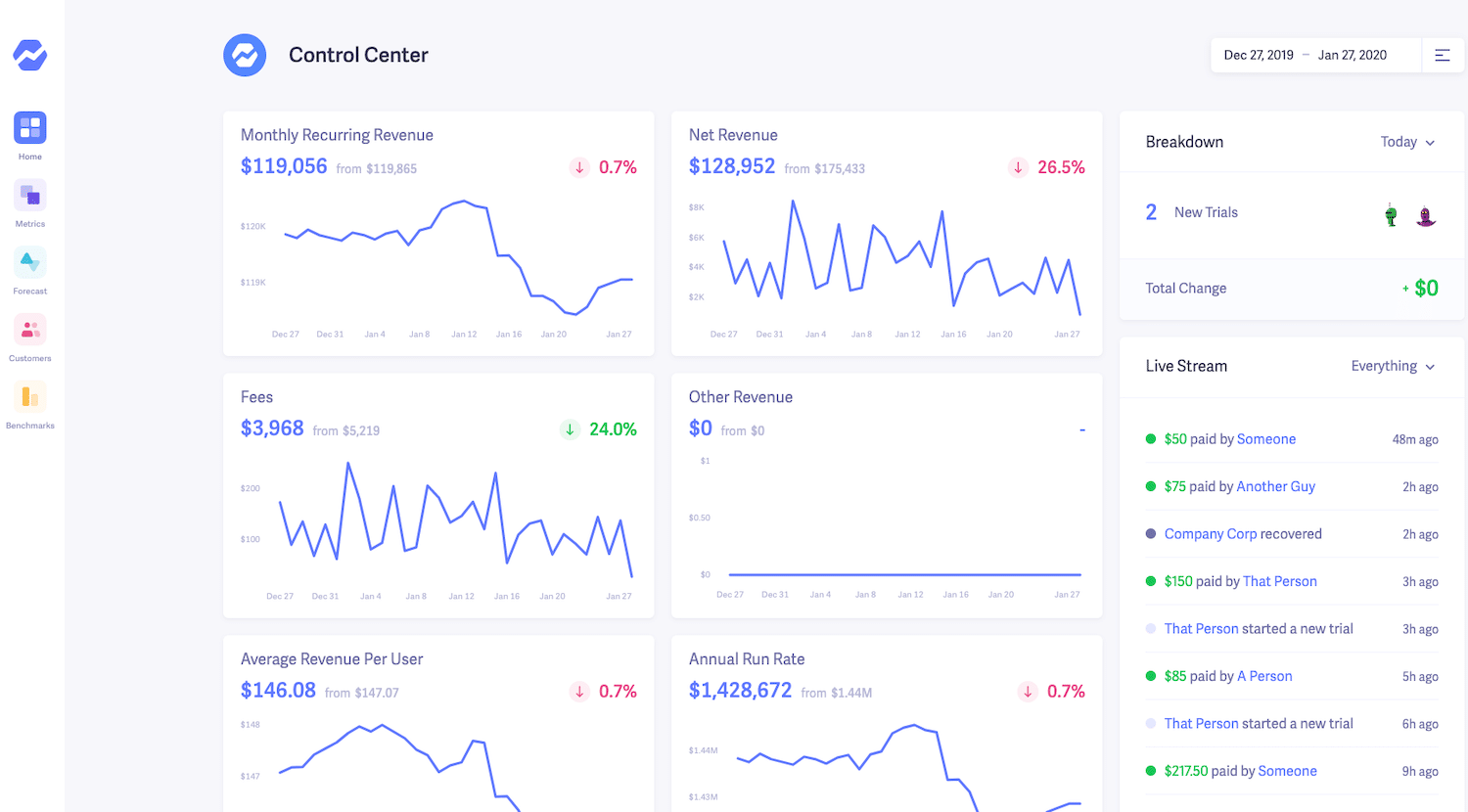
Customer Support
These are the tools we use to handle customer requests and inquiries at Kinsta.
4. Intercom
Intercom is a customer platform with a suite of products for live chat, marketing, feedback, and support. Remember, support is key to any successful company. So if you want our advice, make sure you have a sound support system in place, whether this is chat, tickets, etc.
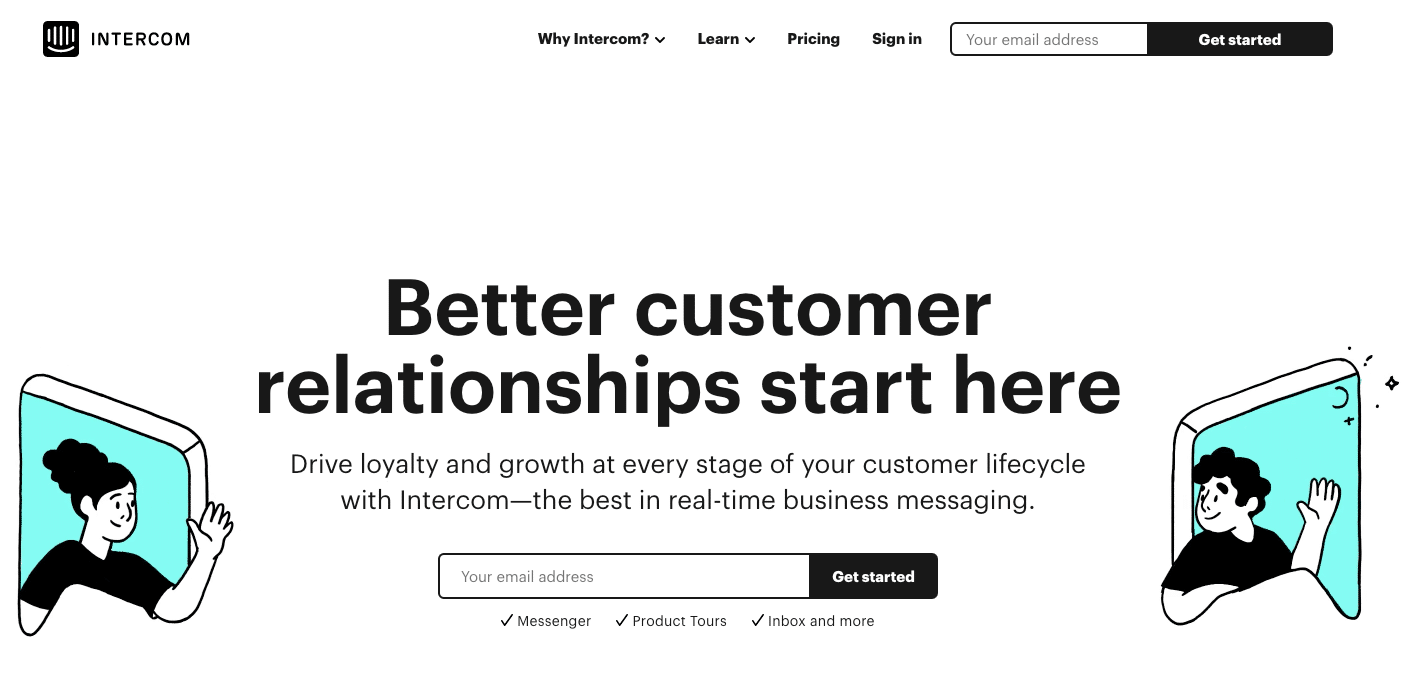
We have used Intercom since day one here at Kinsta, and it has worked very well for us. We pride ourselves on providing support from team members who are professional developers, and work with WordPress every day, contribute to WordPress Core, and other open source projects.
As a result, the expertise of our support department is second to none. Nothing is worse than launching a chat session and feeling like you know more than the person on the other end. That will never happen at Kinsta!
Intercom has provided an easy way for us to integrate chat and support tickets (see below) it into our dashboard, so customers know we are always one click away, 24/7. Our median support ticket response time in 2019 was 1 minute and 27 seconds!
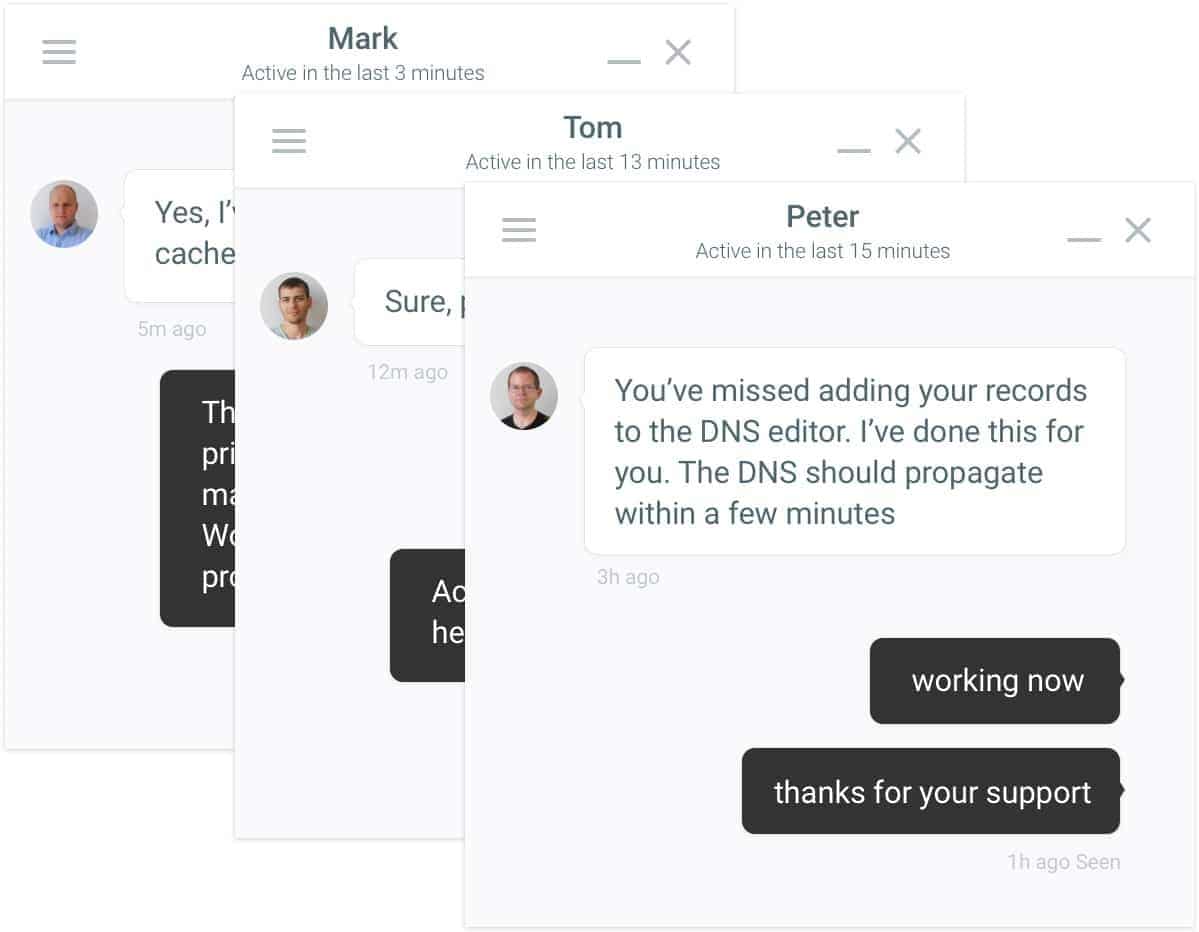
It is one of our favorite SaaS products.
Collaboration and Internal Communication
We use a range of SaaS products to help improve our collaboration and internal communication.
5. Slack
You have probably heard of Slack by now! If not, you should immediately give it a try.
Slack is a messaging app for teams designed to make communicating with your colleagues fast and easy, no matter what platform they are on.

Every member of the team at Kinsta uses Slack on a daily, or probably hourly basis. It helps us do everything from chat about industry news, collaborate on team projects, and of course, share an occasional Giphy.

We use the paid version, but the free version works great as well if the few limitations do not bother you. Slack is excellent for any company just starting, especially for remote teams.
Kinsta’s team is spread across multiple continents, so we depend on Slack for communication across timezones and platforms. When it comes to SaaS products, this is a must-have.
Make sure to check out our guide on how to use Slack effectively.
Obviously, there are some really great Slack alternatives out there. We collected them together in this detailed post.
6. Trello
Trello is an online collaborative tool that allows you to easily create boards, lists, and cards to organize your projects. Trello is used by businesses all over the world, some of which include Adobe, Pixar, Google, PayPal, and National Geographic.

We love Trello here at Kinsta!
Trello allows us to easily create tasks and keep track of who is working on what. Even for our blog and inbound marketing activities, we have a Trello board to keep track of new topics, ideas, and setting deadlines.
Sharing a board is as simple as one click. We use the free plan, which makes this another must-have tool for startups!
Btw, Asana is another great project management tool worth to take a look. To compare the features, make sure you check out our detailed Trello vs Asana guide or this comparison on the best Trello alternatives.
7. Google Workspace (Email + Collaboration Tools)
Nobody likes getting emails, and it seems that everyone is continually striving and failing to reach that inbox zero goal (is it though? 🤔).
But every company needs a way to communicate through email. When it comes to email hosting, there are a lot of options to choose from, such as Zoho, Office 365, Rack Space, and Google Workspace.
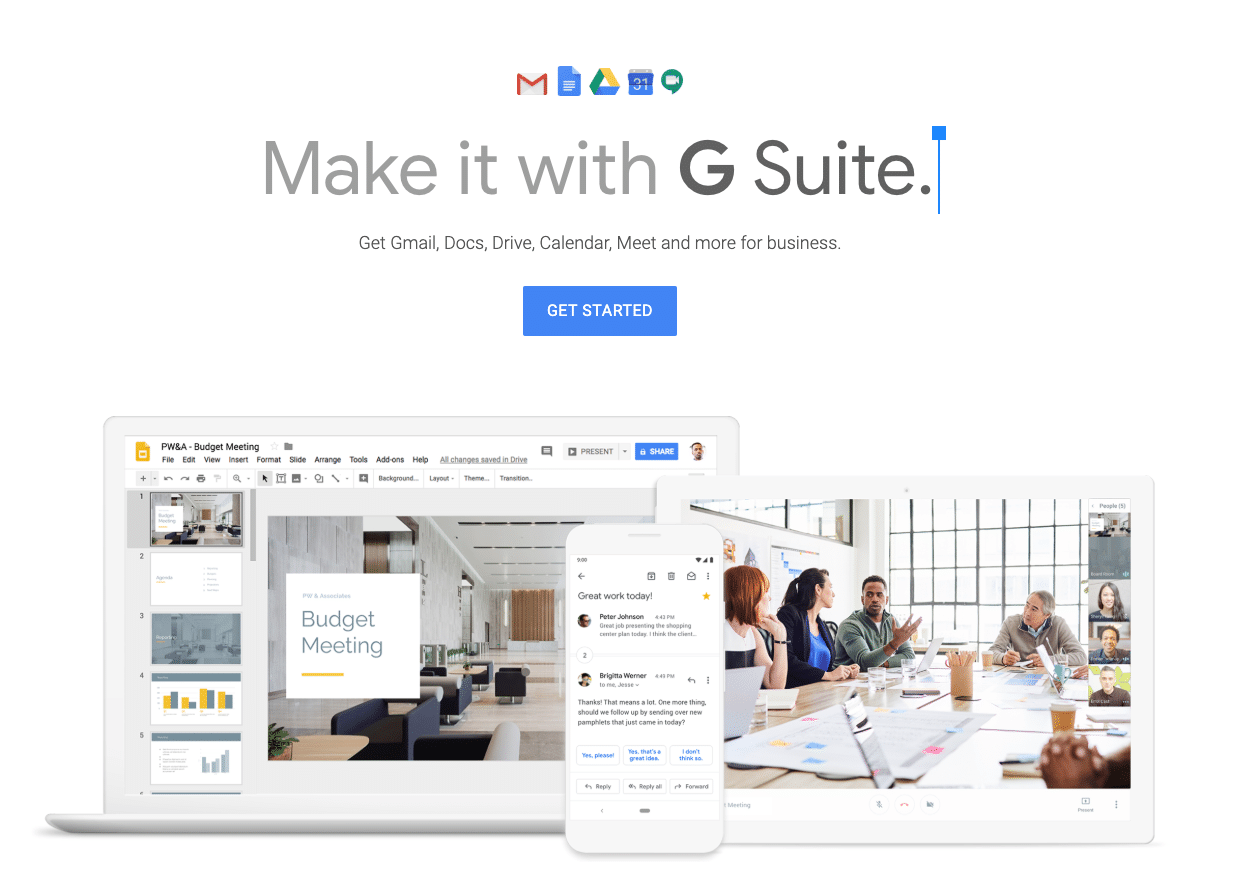
The Google Cloud Platform powers Kinsta’s application hosting, database hosting, and managed WordPress hosting, so obviously, we’re big fans of its infrastructure and apps.
We use Google Workspace for email hosting, which allows every employee to have a professional and unique @kinsta.com email address and access it via Gmail or their favorite email client.
And when it comes to Gmail (and its add-ons and extensions), you hardly can go wrong. According to Email Market Share, as of December 2019, Gmail accounts for 25% of email clients usage based on the number of opens.
The basic Google Workspace plan, which is the one we use at Kinsta, is priced reasonably at $6 per user per month. It also gives everyone 30 GB of online storage for Google drive and access to Google Docs, which we use a lot here at Kinsta.
For more tips on how and why we use it, please check our detailed guide: The Benefits of Google Workspace for Your Business.
8. Dropbox
500 million people around the globe, along with over 200,000 businesses, use Dropbox on a regular basis to access and share documents and files on the go.

We use Dropbox at Kinsta to share large files and enable them to be more easily accessible by remote team members from anywhere, no matter what platform they are working on.
9. Zeplin
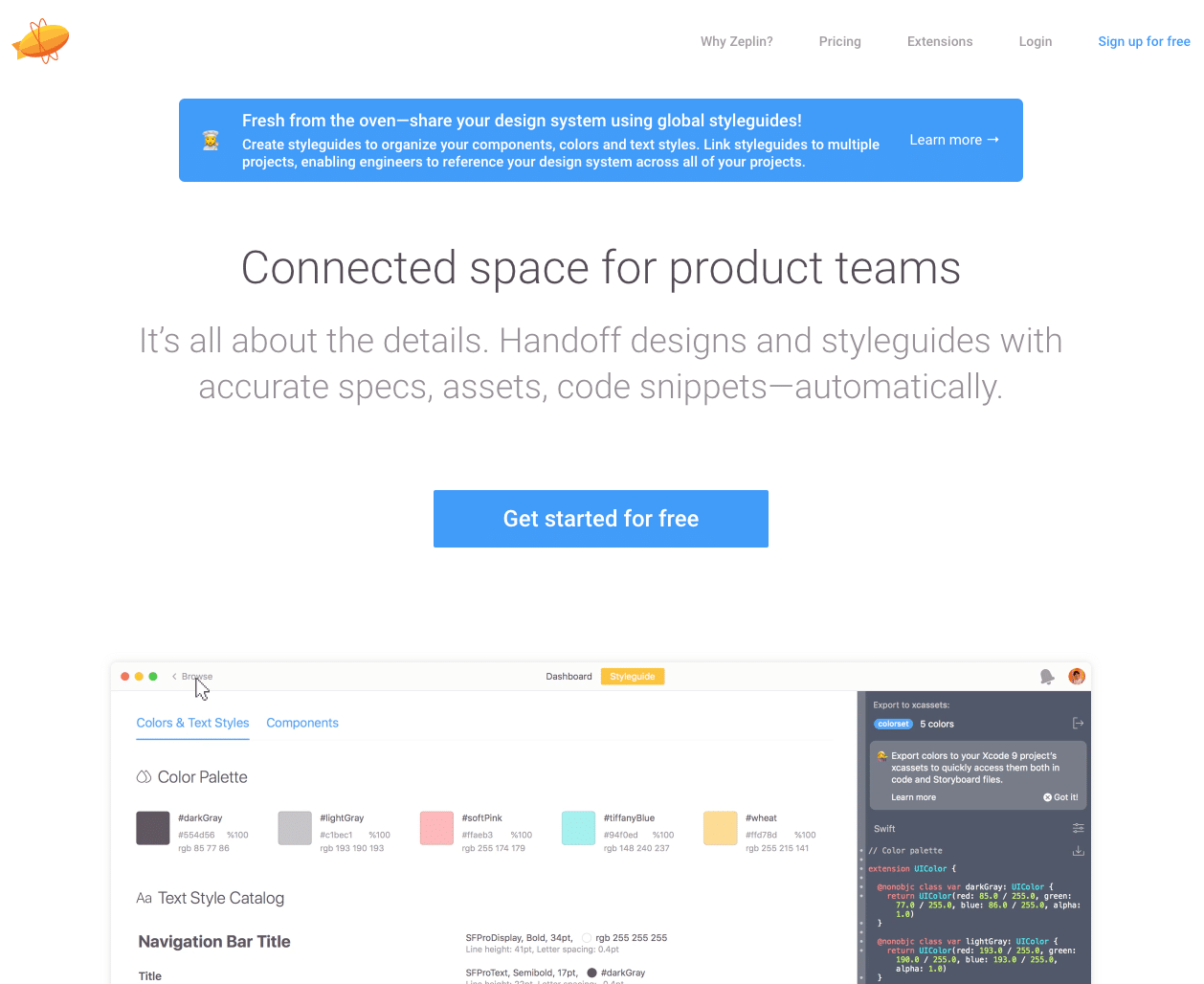
Zeplin is a collaboration tool specifically designed for developers and designers. It makes it easy to create, collaborate on, and share design and style guides complete with assets, specs, and code snippets.
Our developer teams use them to ensure that everyone follows the same standards, and stay on the same page during complicated projects.
10. Zoom
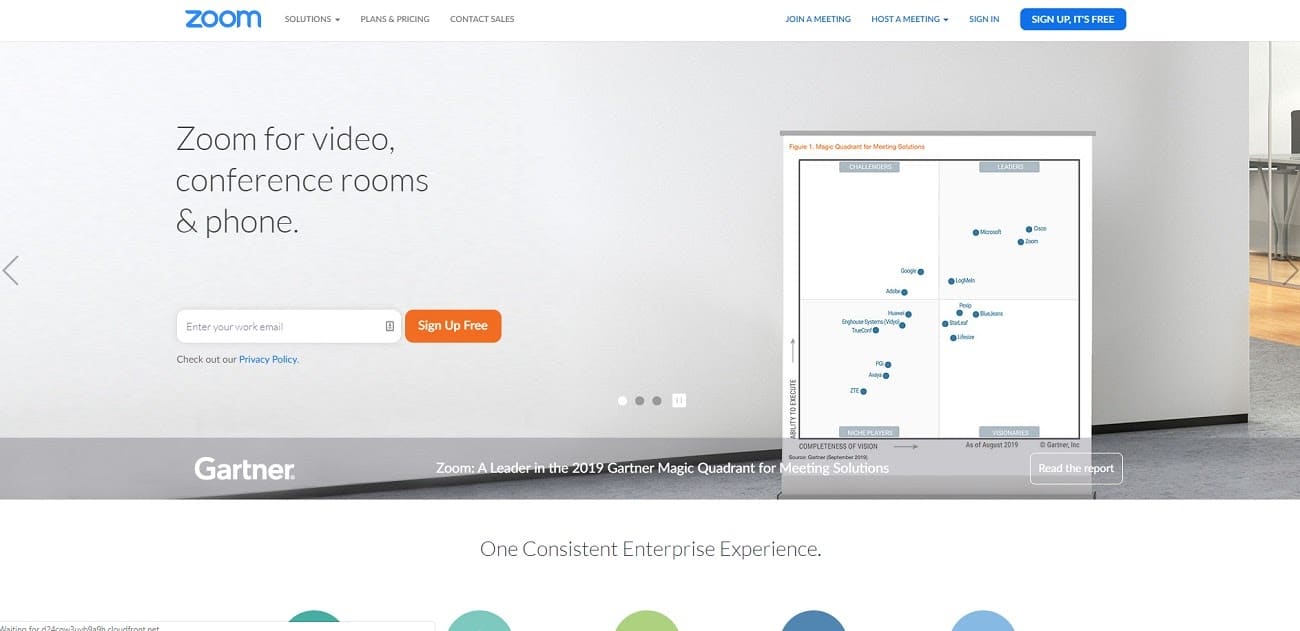
Zoom is a next-level video conferencing tool. It works great on all devices, from smartphones to tablets to desktop.
At Kinsta, we use Zoom to enable close-knit collaboration between team members that are on all different corners of the globe. Plus we run monthly AMAs where team members share more details about their role within the company and personal hobbies.
11. Atlassian: Jira + Confluence
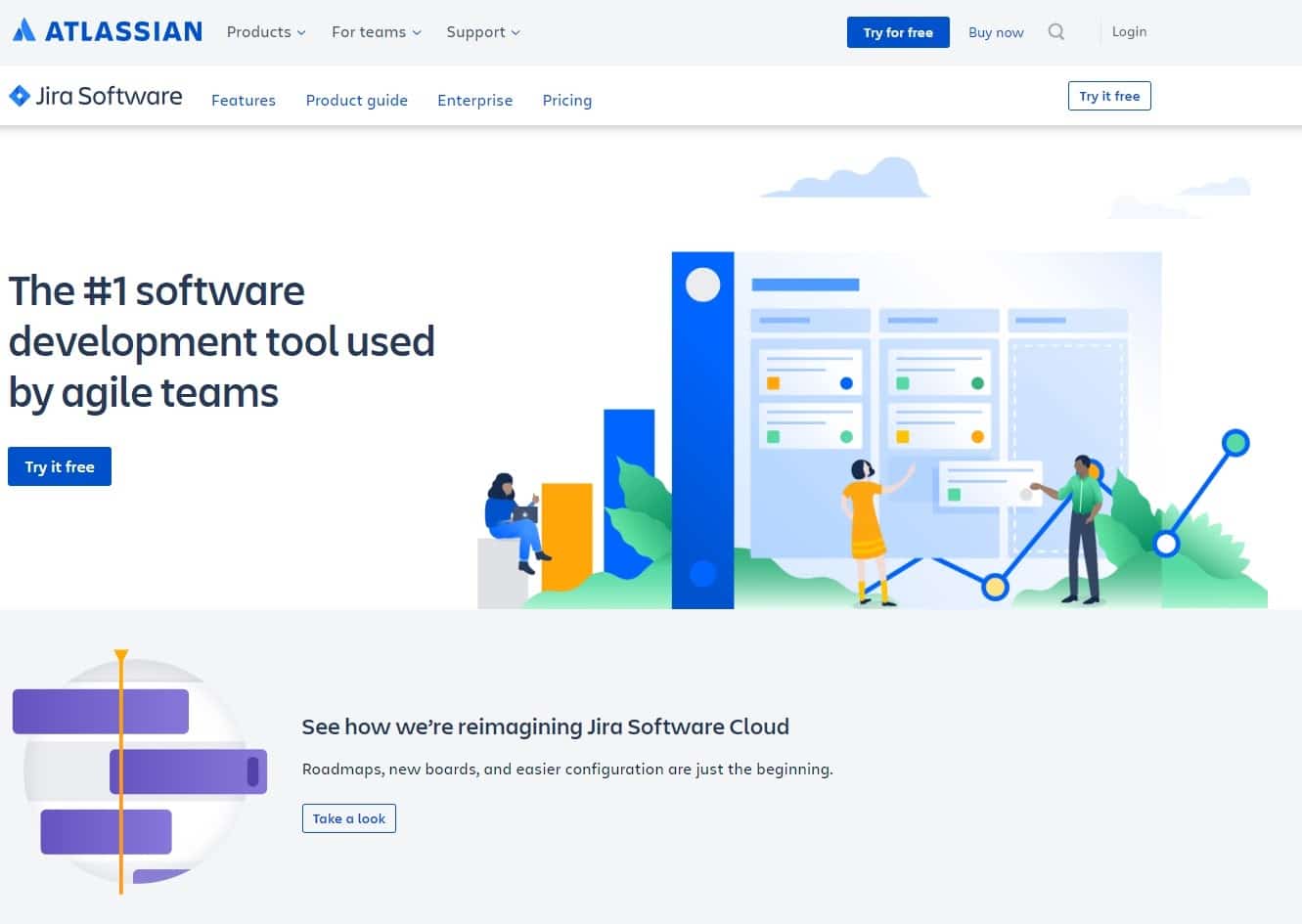
For software development, deployment, and documentation we use a combination of Atlassian’s Jira Software and Confluence.
This helps our team maintain a modern and efficient workflow and minimizes errors in the long run. On top of this, we have an internal resource where all procedures are documented so new employees can conveniently browse through right after their onboarding.
12. Airtable
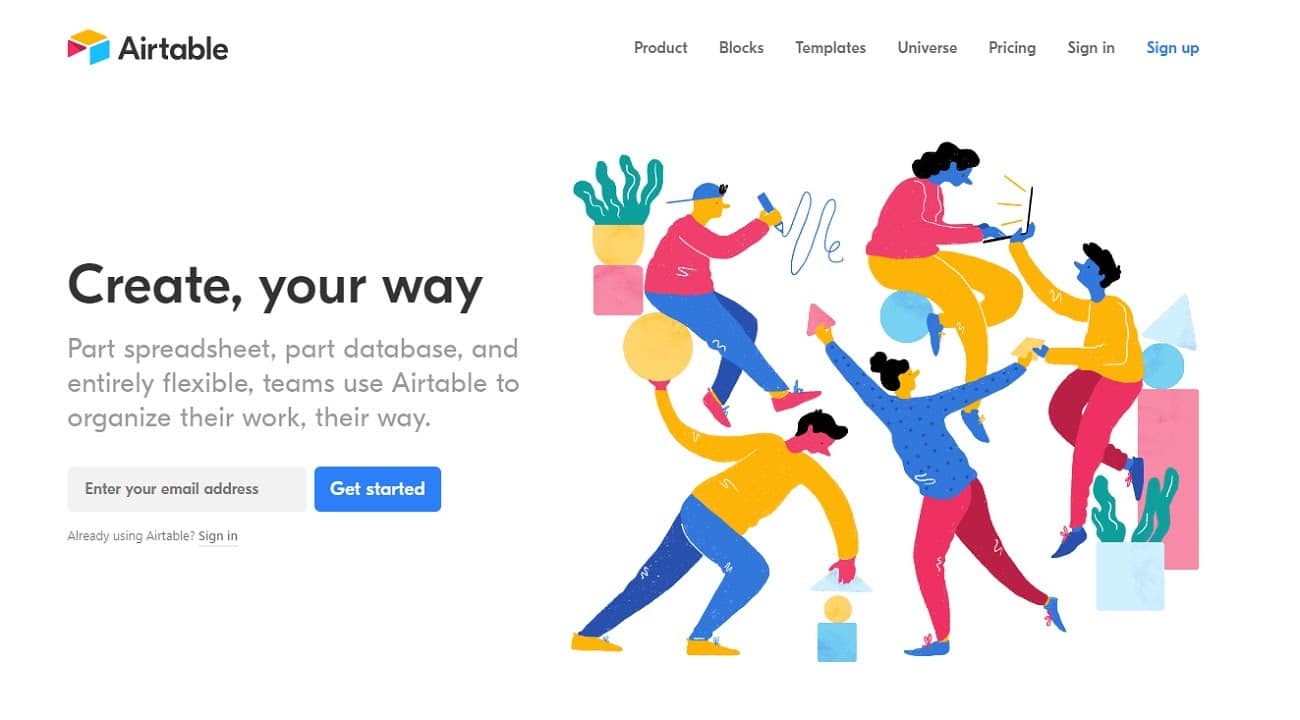
Airtable is a unique tool for task management that enables your teams to organize their work the way they want to.
Our teams mostly use Airtable to collaborate, manage projects and tasks related to customer relationships and lead generation and nurturing as a pretty advanced spreadsheet, which might recall a database some times.
Marketing and Sales
Below, we cover the suite of tools we use to improve our marketing and sales processes.
13. Mention
Keeping up with monitoring your brand on social media is a never-ending process and can sometimes be overwhelming and time-consuming. Mention scans billions of sources in over 40 languages so you won’t miss anything anyone says about your brand.
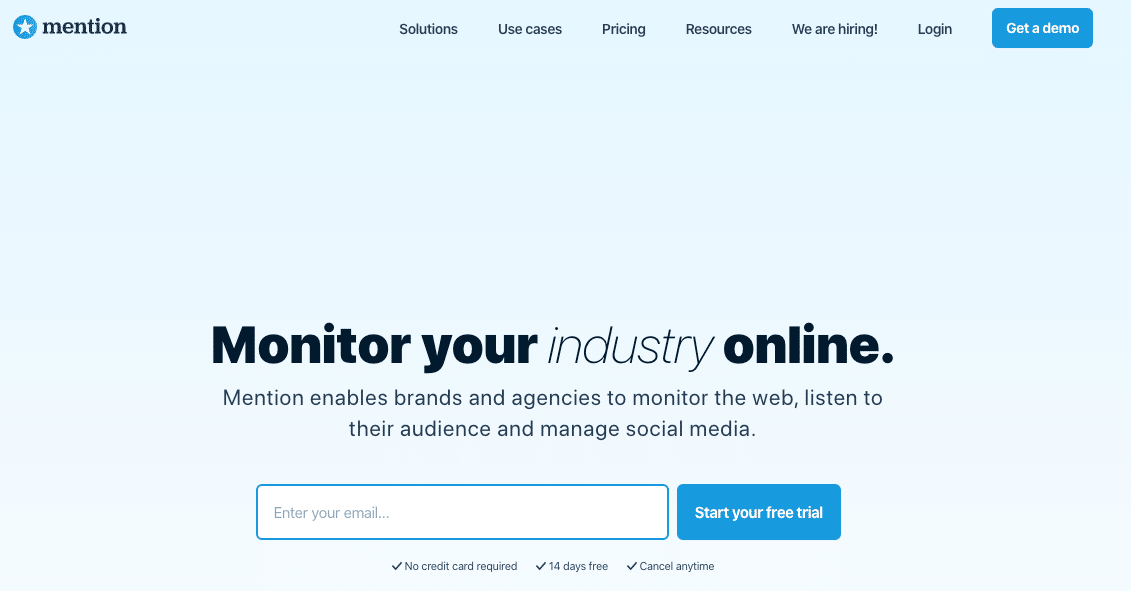
We use Mention to keep track of social mentions of Kinsta around the web. One great feature they have is their integration with Slack.
It allows us to quickly see Tweets and mentions from right within a private Slack Channel, along with an influencer score.
This way, we never have to waste time logging into a separate dashboard or get yet another email.
14. Close
Close is a SaaS product created by salespeople for salespeople.
Nobody likes manual entry and Close tries to automate as much as possible. From calls, emails, and activity, so you can spend more time closing deals instead of entering data.

Our sales team at Kinsta uses Close for lead management, along with the powerful Zapier integrations, to automate it even more. And of course, some of these automation’s include Slack integrations.
15. Hunter

Hunter is the most reliable solution for finding email addresses for leads and prospects, without having to call up and ask every time manually. With Hunter.io, email outreach becomes a much more valuable and efficient sales tool.
Our sales team uses it to help them connect with potential leads and start the sales process.
16. Mailchimp
Mailchimp is used by over 20 million businesses and individuals to send emails to and newsletters.
As they say, “The money is in the list.” Building and maintaining a high-quality email list can be an excellent way for a company to generate more sales and keep its current customers informed.
MailChimp makes this process silly easy and has been perfecting its software for many years.

We use MailChimp here at Kinsta, and we are on a paid plan, but there is also a free one, which allows you up to 2,000 subscribers.
We are creating a lot of content and MailChimp is a great way to allow us to share it with subscribers each week. Make sure to subscribe to our newsletter!
All in all, MailChimp’s free plan is a great solution to get up and going while you start to build your email list.
17. Buffer

Buffer is an integrated, all-in-one solution for managing and driving more engagement from multiple social media accounts.
We use it to help build our brand across Twitter, Facebook, and more channels. It helps us automate mundane tasks, as well as gives us further insights about which of our content works best on social channels.
SEO and Content Marketing
Content marketing and SEO are our main focus at Kinsta when it comes to building our platform. As a result, we use a number of SaaS tools to help improve our processes and help rank our content.
18. AccuRanker
If you do any inbound marketing or SEO on your website, you must keep track of your keyword rankings. SEO is still alive and well, and keywords are still essential.
Even though things have shifted focus more to “topic” writing, keywords will always exist as Google’s algorithm is, after all, a computer algorithm.
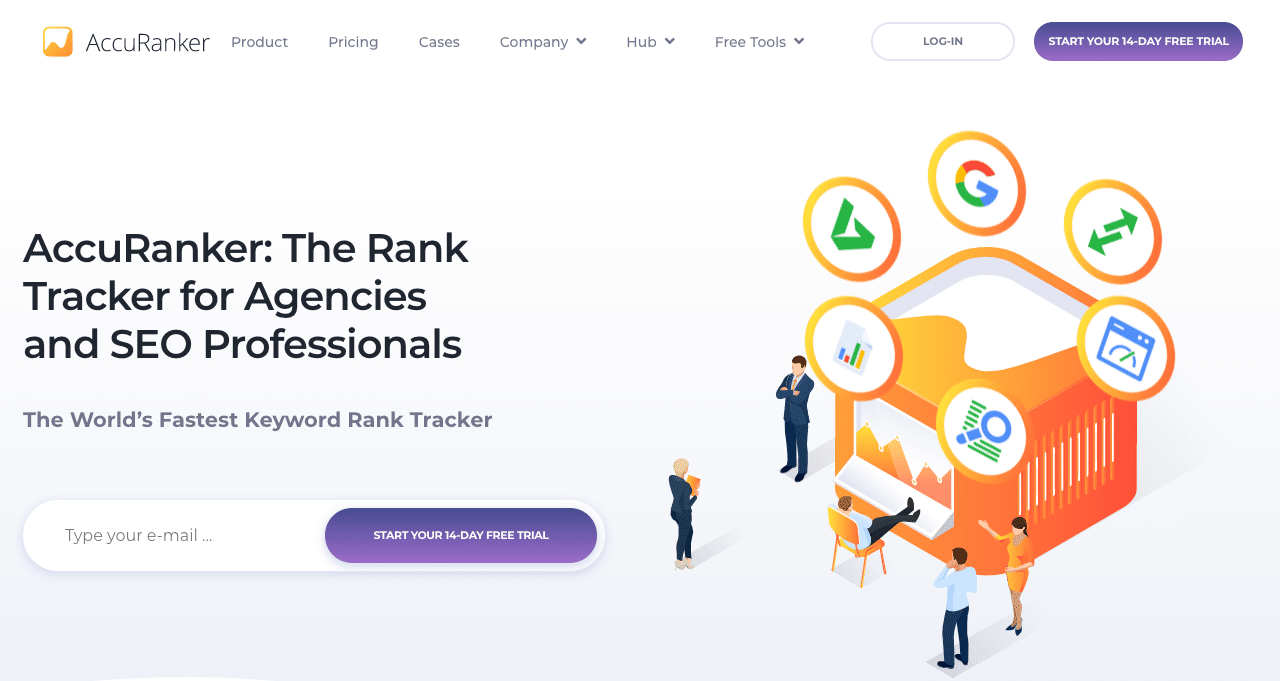
We use AccuRanker at Kinsta to keep track of essential keywords we are focusing on ranking. It tells us whether or not we need to give an article a little more love.
AccuRanker allows us to track the keywords around a blog post, add a note of what we optimized, and then later return to see how our rankings were affected by the changes.
19. SEMrush
SEMrush is an all-in-one competitive data and analytics tool for digital marketing professionals. Keyword research for one is crucial if you are doing inbound marketing for your company, as well as getting a feel for where your competitors stand.

We use SEMrush at Kinsta to research new blog post ideas and strategically make data-driven decisions for our inbound marketing. This tool allows us to quickly see things such as search volume for a keyword or topic as well as how competitive that keyword is.
When it comes to keyword research, never assume people are searching for it. Always test that and see if it’s worth investing time and resources on it.
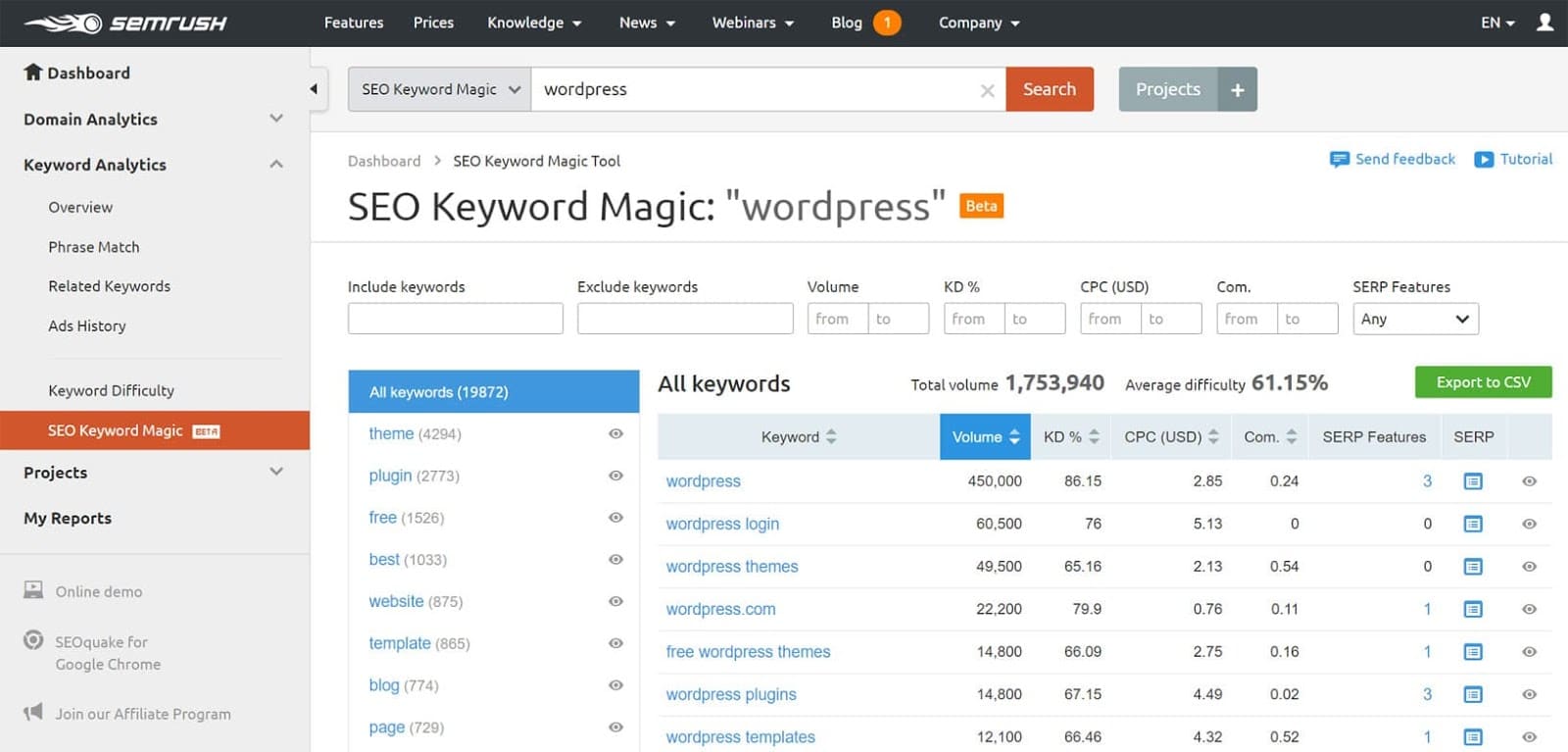
20. BuzzSumo
BuzzSumo is a fantastic tool for content marketing research. It can help you identify trends and find valuable influencers to recruit to your brand.
With unique content insights, you can quickly generate new ideas for your content strategy.
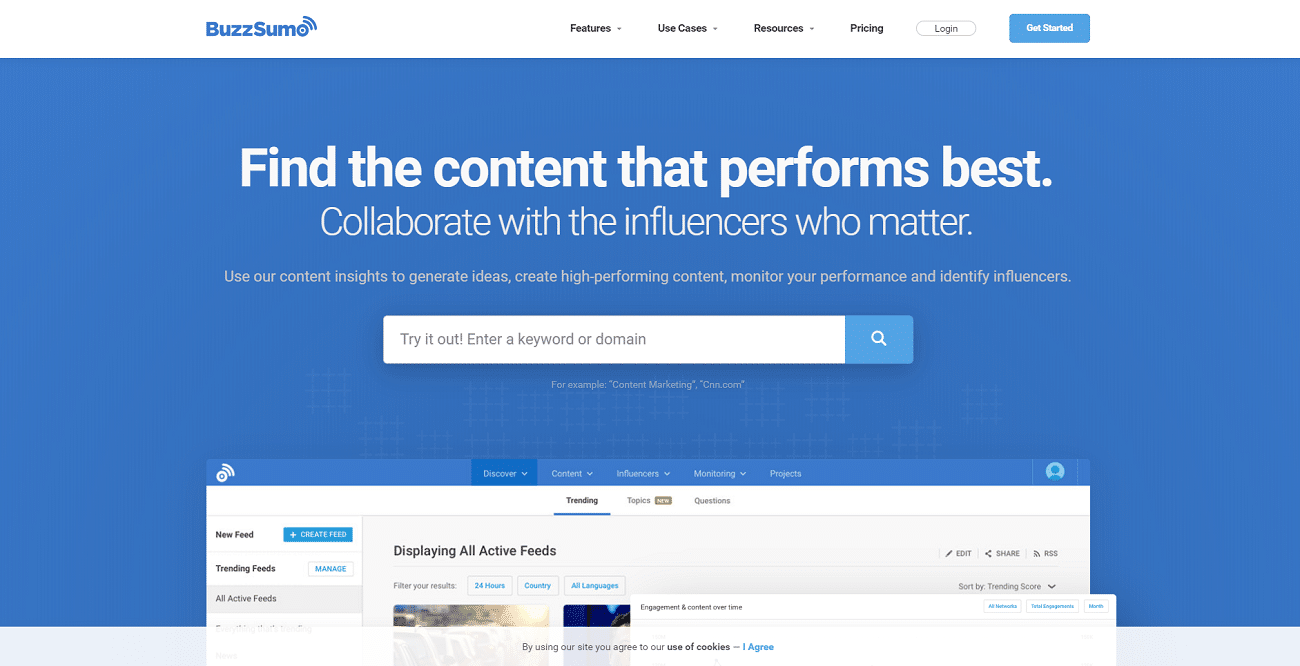
Here at Kinsta, we use BuzzSumo to make sure we are on the right page when it comes to our content marketing efforts.
Instead of just relying blindly on keywords and search data, we use it to find trends we can take advantage of with blog posts and articles.
Their web content research tool is the perfect fit for our content strategy.

It helps us remain on the cutting edge in our industry, without spending all day worrying about content.
21. MarketMuse
MarketMuse is an AI-based content planning and optimization solution. It analyzes the top content for search terms and keywords on Google.
Through this in-depth analysis, it can highlight essential topics, keywords, and questions that you should cover in your content.

At Kinsta, we use MarketMuse to ensure that we cover all relevant topics and questions when we write a post.
Our forte is long-form content, so it’s a match made in heaven for us. It helps us dot the Is and cross our Ts, both SEO-wise and content-wise.
22. Ahrefs

Ahrefs is an all-in-one SEO solution that can help you with plenty of activities such as keyword research, competitor research, SERP, and keyword monitoring just to name a few.
We use it to help us identify high-value, low competition keywords to target with content from our blog and other pages. Ahrefs has played a key role in growing our organic traffic and making content marketing one of our best channels for customer acquisition.
23. Crowdin

Crowdin is a localization management tool that helps distributed companies manage their multilingual content.
We use Crowdin to make sure we speak the language of our customers, no matter where they are located. It helps us provide a better experience to our global customers.
24. Quuu Promote
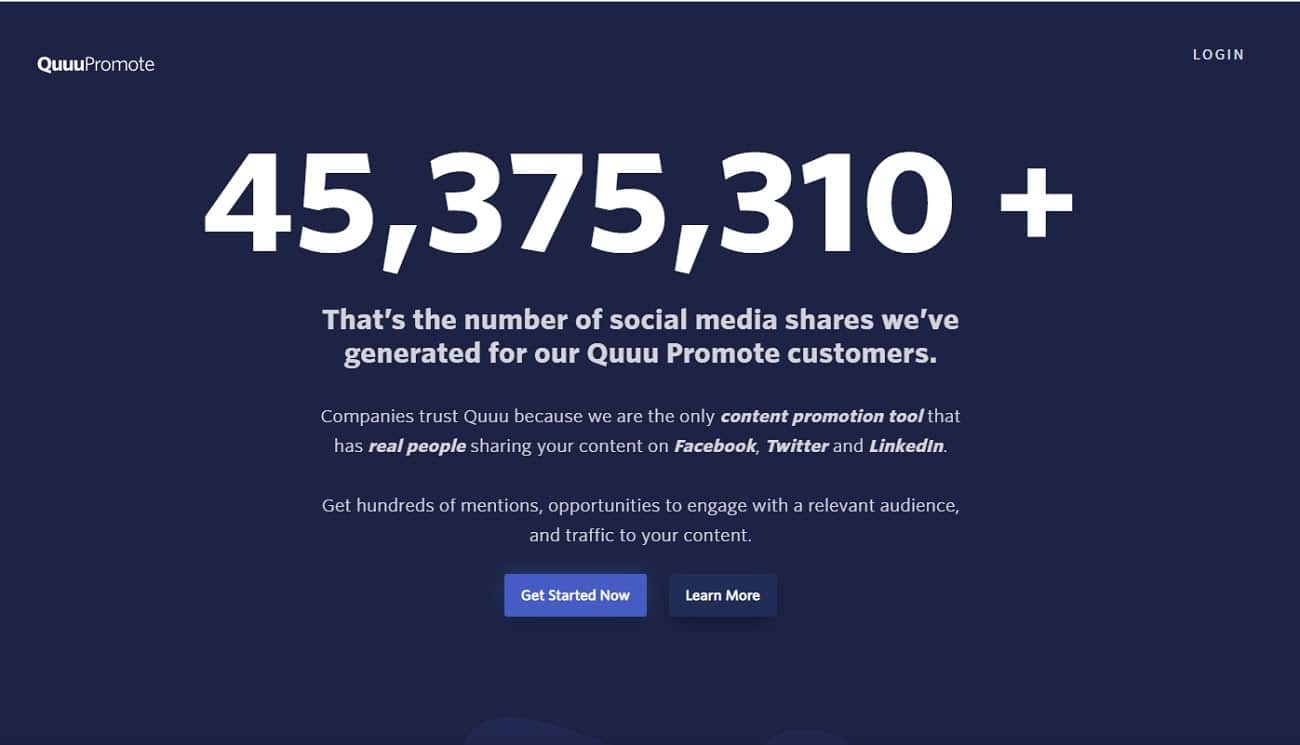
Quuu Promote is a social media promotion solution that helps you get shares and reach new audiences with each new post. It gives you access to real people on Facebook, Twitter, and LinkedIn.
At Kinsta, we use Quuu Promote as part of our social media marketing strategy. It helps us reach a larger audience with every post and establish our brand in new areas.
Analyzing Web Traffic
At Kinsta, we believe in taking a data-driven approach in all that we do. That’s why we rely on an analytics SaaS products to help us stay on top of things.
25. Crazy Egg
Crazy Egg is a heat map and website data analysis tool that helps you dive into how people are interacting with your website.
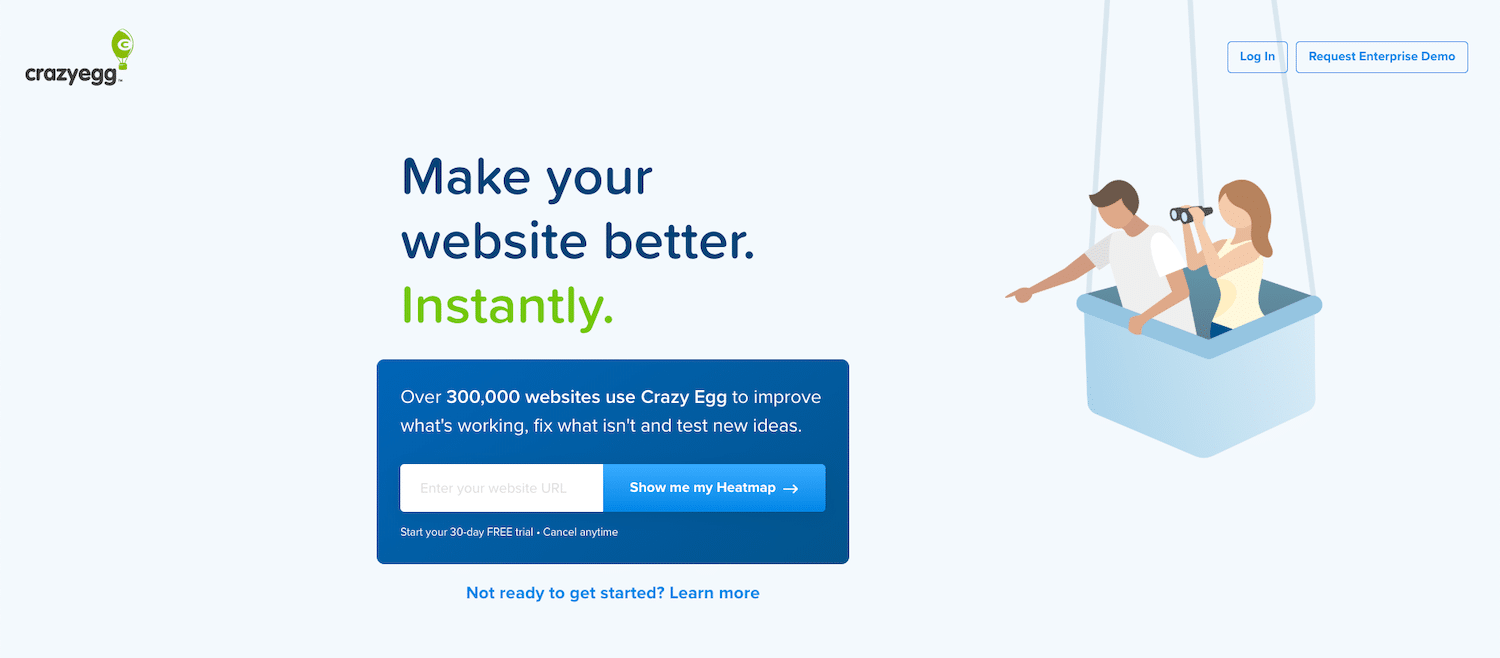
One of the main features we use at Kinsta from Crazy Egg is the excellent heatmap feature! You can just set up an experiment, let it run, and come back to see exactly where people are clicking on your website.
See how many people scroll down the page, where they stop, and what sources of traffic are clicking on what. Crazy Egg is great for improving your CRO and testing out new landing pages.
26. Google Analytics
Every company with a website has heard of Google Analytics. But very few use the website analytics tool to its full potential.
From detailed channel breakdowns that show pageviews, bounce rates, and conversion rates by source, to flow charts that show how users interact with your website, Google Analytics has it all.
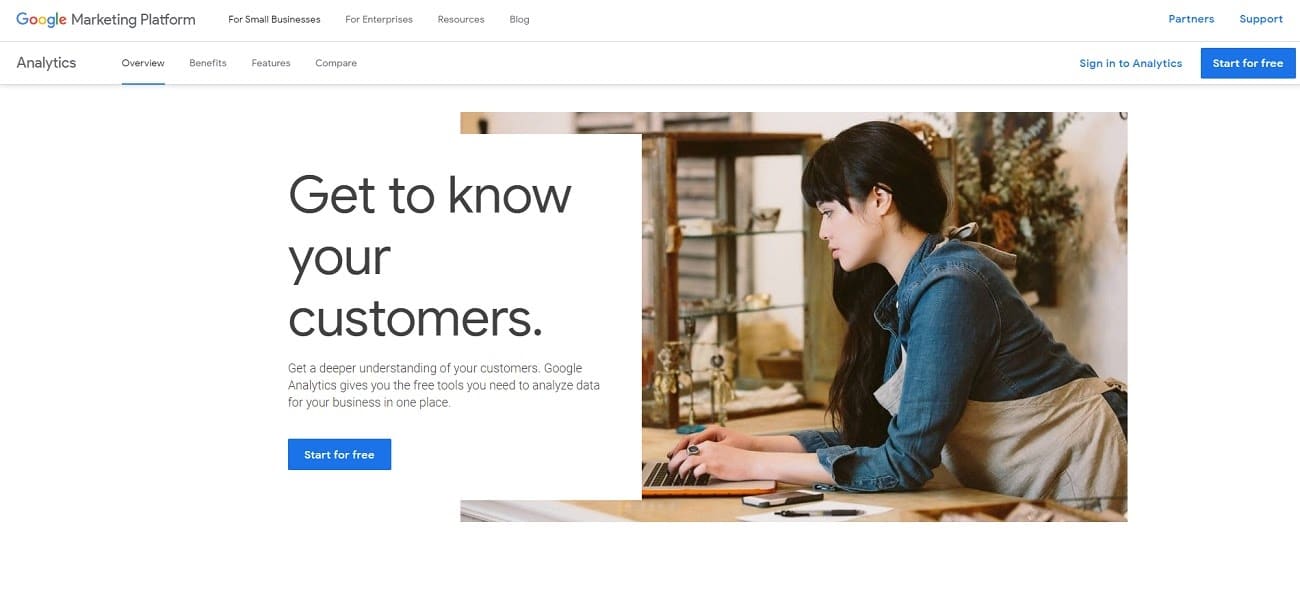
Here at Kinsta, we use Google Analytics to help us better understand our readers and users.
The detailed reports give us a better understanding of what content works and what content doesn’t.
We can also identify problems with navigation and specific weak points by examining our user flow reports.
Check our in-depth guide on how to add Google Analytics to your WordPress site.
27. Hotjar
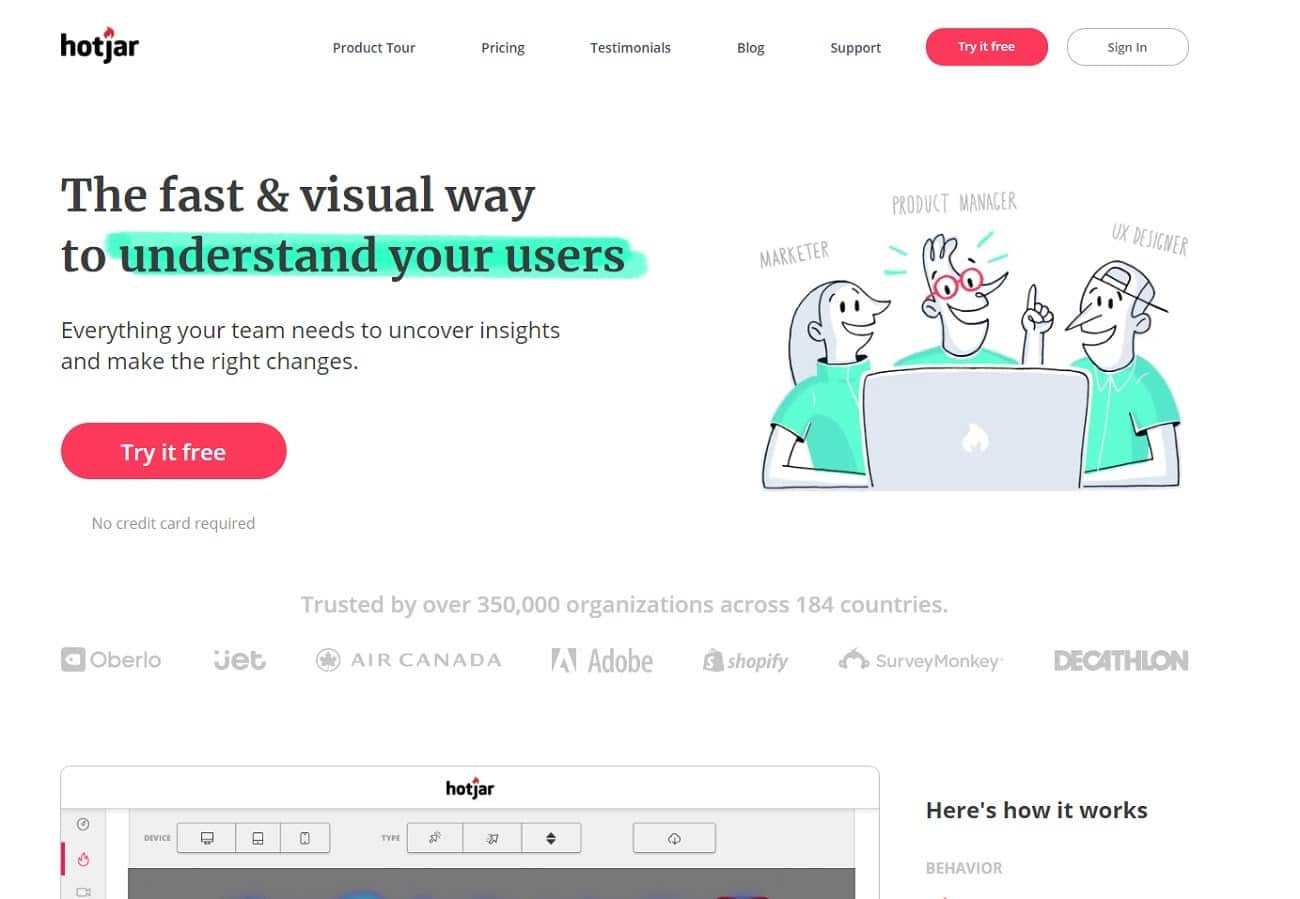
Hotjar is an advanced analytics and user experience mapping tool that helps you improve your UX, design, and web apps/websites in general. You can track your visitors’ journey in videos that your design/development teams can dive into and dissect.
You can also view heatmaps and other visual breakdowns of how users interact with your website or app.
We use Hotjar to improve the experience for all our users, to make sure we are providing the easiest and most intuitive UI and UX available in a hosting solution.
Server and Hosting
To make sure that our hosting solutions are cutting-edge, we rely on a number of specific SaaS products such as:
28. New Relic
New Relic offers all sorts of services, from application performance monitoring, server monitoring, mobile monitoring, and real-time user insights.

While we use the built-in Kinsta APM tool for site monitoring here, you do have the option of also using New Relic, but having your own license is required.
Check out our in-depth post on how we use New Relic at Kinsta to troubleshoot performance issues on clients’ sites.
29. Cloudflare
Cloudflare is a free global CDN (or rather fully proxy service), DNS, DDoS protection and web security provider that can speed up and protect your website.
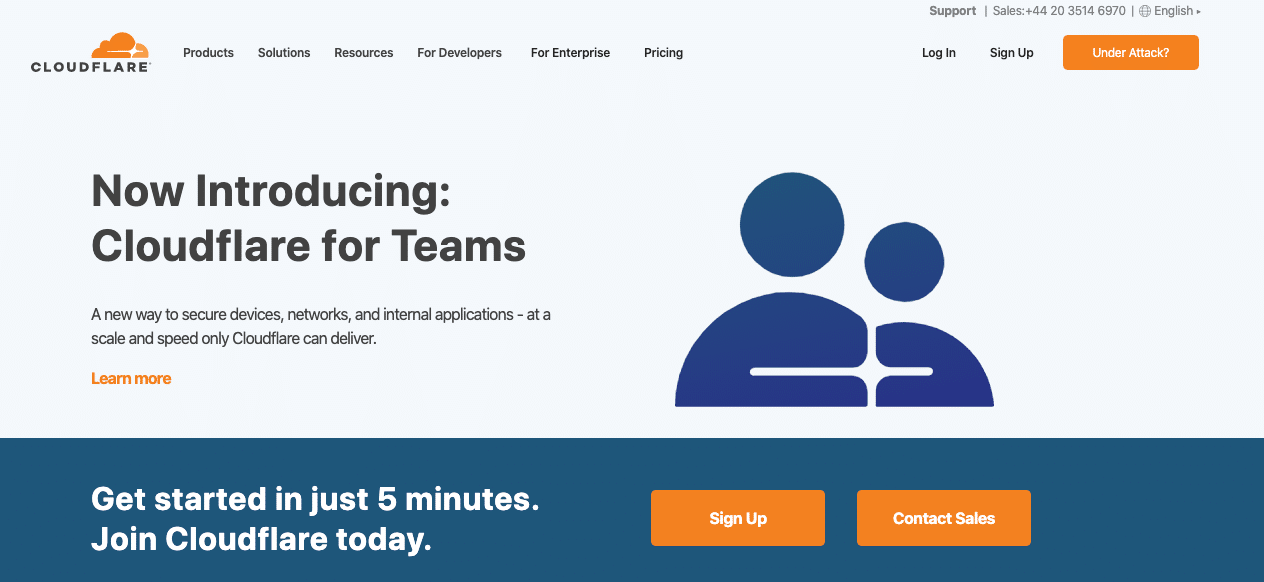
Kinsta uses CloudFlare for customers who are looking for a free and or premium solution to speed up their websites around the globe while also offering DDoS protection. Another advantage our customers get is that they can save a lot of bandwidth.
Typically a CDN will handle the delivery of 60-70% of a website’s traffic load. So by offloading assets to a CDN, this can ensure you don’t go over your bandwidth limit with Kinsta. Make sure to check out our CloudFlare integration guide, our KeyCDN integration guide, and our CloudFlare APO guide.
30. Github
As many of you probably know, Github is a free open source repository that is used by people, companies, and developers to help build software. GitHub allows teams to contribute and fork to over 38 million projects, including WordPress itself.

We don’t do anything publicly available to people on GitHub, but the team at Kinsta uses GitHub to manage our internal development for our website and other projects.
If you work in a group setting with any code, then GitHub is incredible because it offers a version control system that allows multiple developers to contribute and commit updates easily.
Want to know more about version control? Check our git vs GitHub guide.
31. Amazon Route 53
Amazon Route 53 is a highly available and scalable cloud DNS service. It is designed to give developers and businesses an extremely reliable and cost-effective way to route end users to Internet applications.
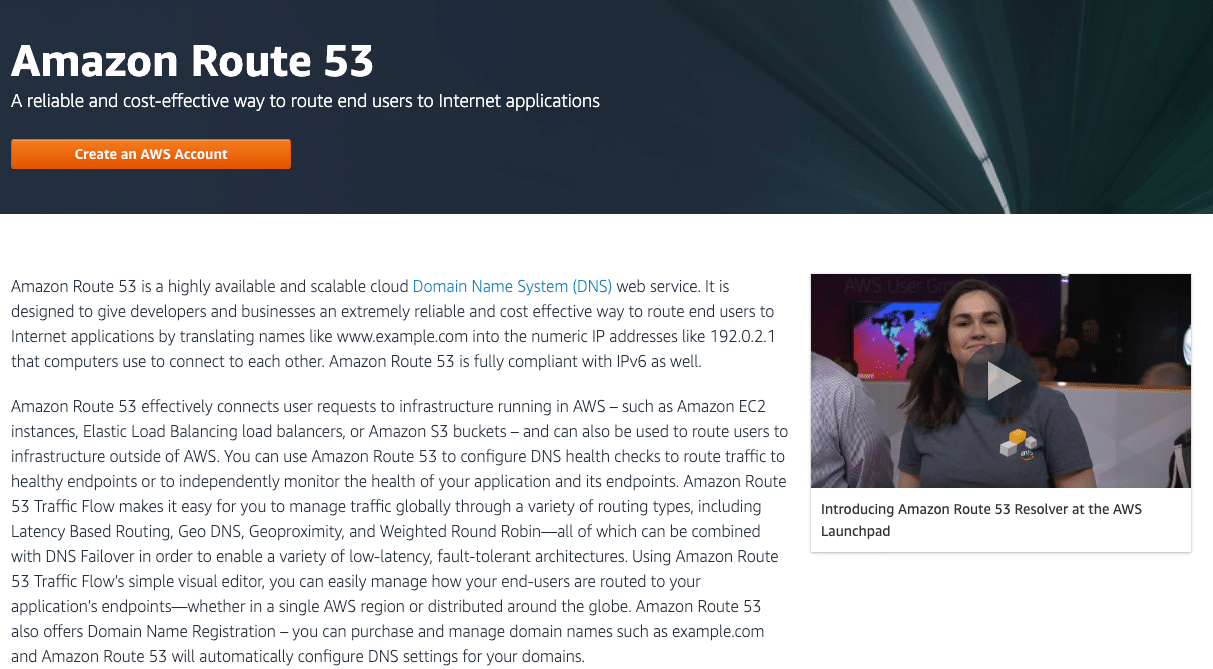
Here at Kinsta, we don’t settle for mediocre when it comes to web performance and reliability. DNS is just one area that we take very seriously. We include Amazon Route 53 premium DNS services for every customer that hosts their WordPress website with us.
Amazon has an enormous infrastructure and a long history of providing additional DNS features such as latency-based routing, Geo DNS, traffic flow, and, most important, DNS failover. Kinsta customers can even modify their DNS records right from their MyKinsta dashboard.
32. Statuspage
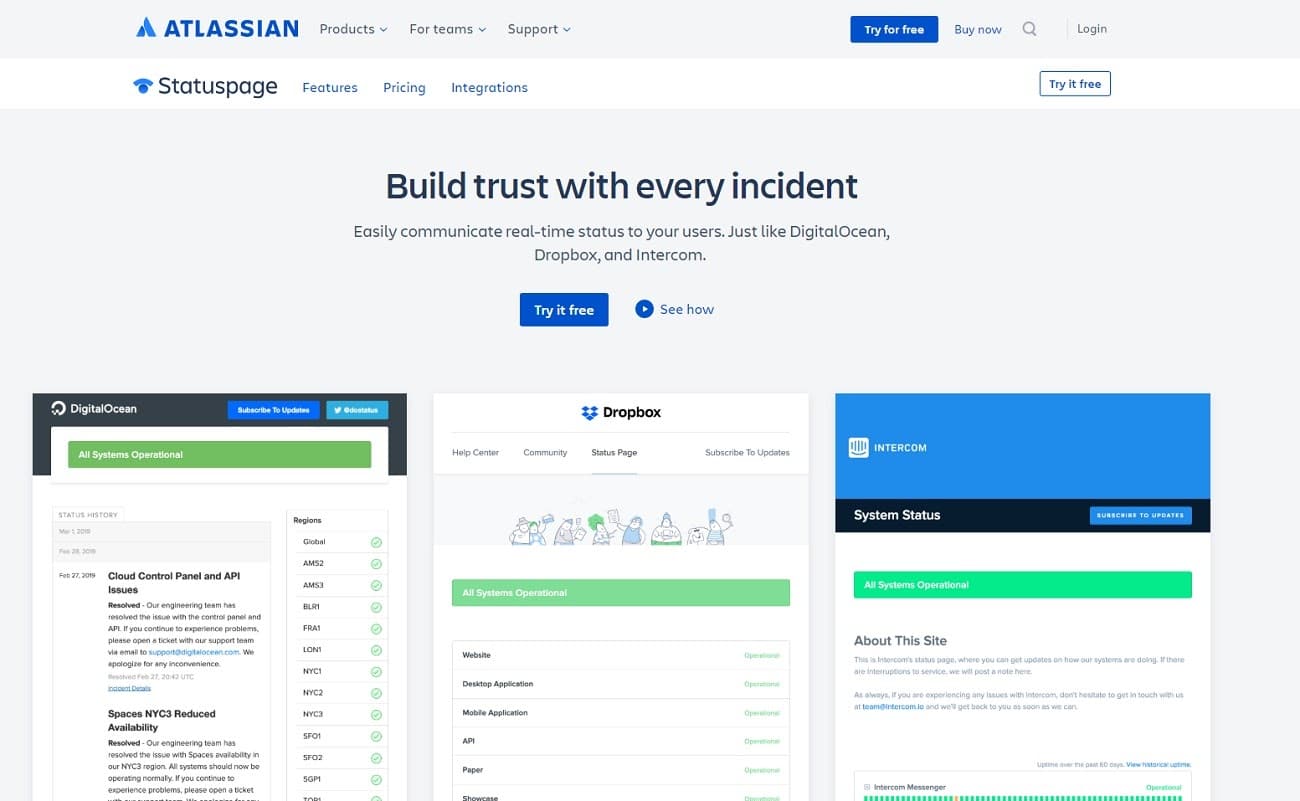
Statuspage is a tool that helps you communicate the real-time status of your servers, app, and service to your customers. Major platforms like Dropbox use this to make sure their user base is always up to date.
And that’s exactly what we use it for here at Kinsta as well. It helps us automate communication during incidents, so our technical team can focus solely on fixing the issue ASAP.
33. Wistia
Wistia is a high-end video hosting and analytics platform. We like to think of Wistia as the Roll’s Royce of video hosting used by companies such as Moz, MailChimp, and HubSpot.
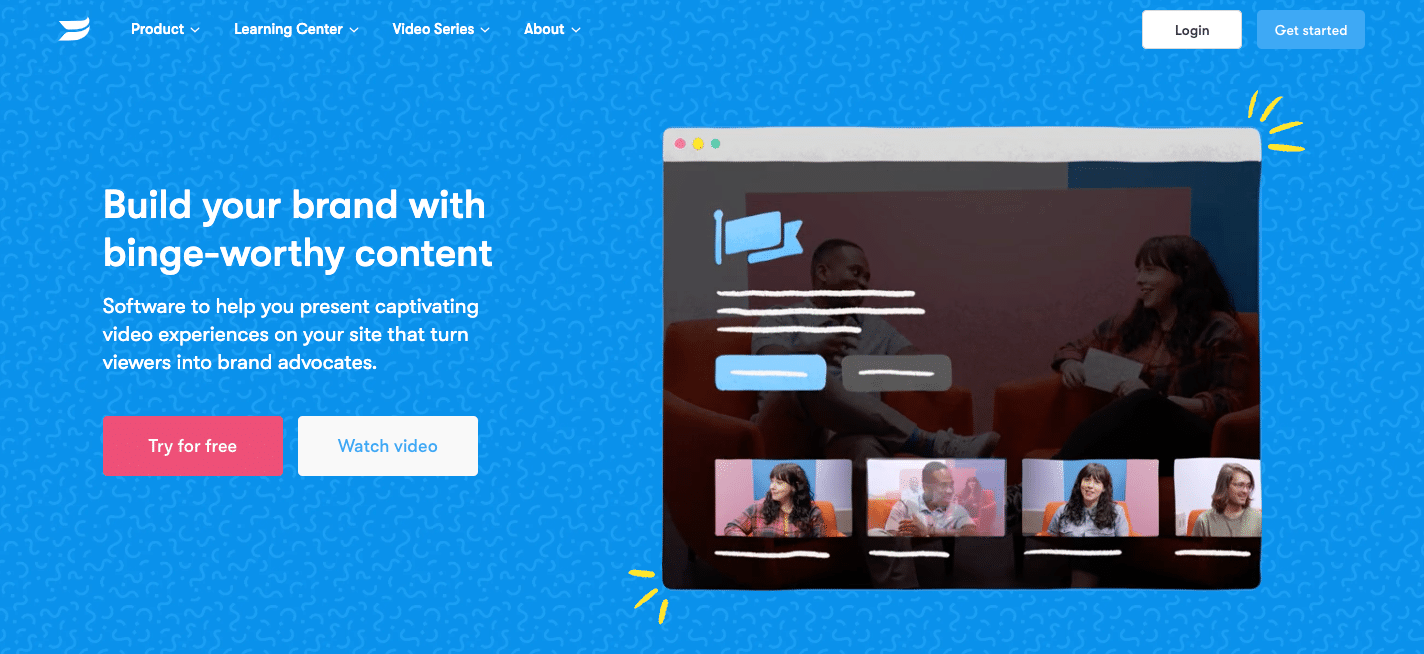
We use Wistia at Kinsta to showcase our customer testimonial videos. While there are other similar platforms we could use, such as YouTube and Vimeo, we chose Wistia because of the seamless integration it provides with our website.
If you want an elegant looking HTML5 video player integration, then Wistia is one you should check out. And if you are OK with Wistia branding on your player, they offer up to 5 videos hosted for free. It can be a great alternative to YouTube for newer startups.
Billing and Accounting
Billing and accounting isn’t the most fun aspect of running a business. But with the right tools, it becomes a lot easier.
34. SendGrid
SendGrid is another email marketing platform and service which focuses on transactional emails. Some of its clients include Uber, Spotify, Airbnb, and Yelp.
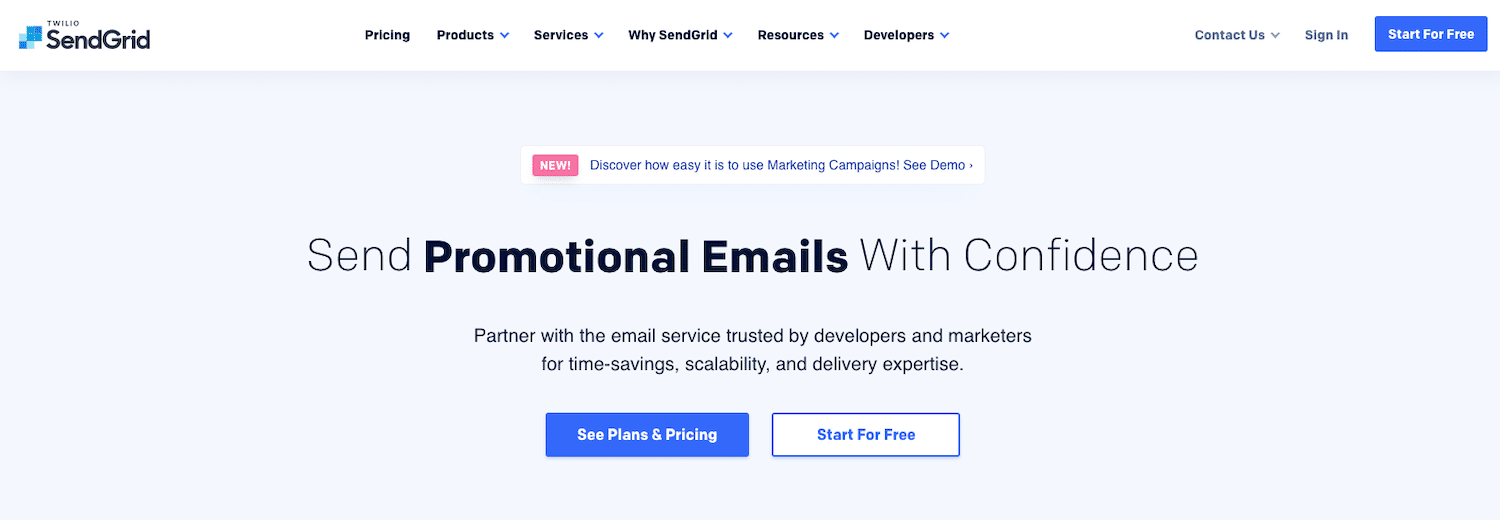
While MailChimp works great for our inbound and content marketing, we use SendGrid at Kinsta for the transactional side of things. For example, emails between servers and applications.
Like many other companies, we previously used Mandrill (owned by MailChimp) until it was shut down.
For transactional based emails, SendGrid is a much more cost-effective solution. If you send a lot of emails from your software or applications, SendGrid does an excellent job. If you would like to get started, take a look at this complete Sendgrid setup guide.
However, we don’t necessarily recommend them for typical marketers. There are little things such as the UTM parameters having to be manually updated for each campaign, which can be a bit frustrating. Its WYSIWYG builder has improved tremendously over the past years, though, and the Sendgrid team is working hard to provide similar functionality as services such as MailChimp. But remember, Sendgrid’s focus is on transactional emails, not marketing.
35. ClearBooks
Unfortunately, the not so fun part of any business is having to run the books, payroll, and accounting. But it is one of those things every business owner must do.
ClearBooks is an online accounting software that tries to simplify the process both for startups, small businesses, and even accountants.

We use ClearBooks at Kinsta partially because they are a UK company, but also because they have a lot of experience with simplifying the online accounting process.
None of us here at Kinsta are accountants after all. Having launched in 2008, they are not new to the financial market and are accredited by ICB, ICAEW, and ACCA. If you are in the UK, ClearBooks might be one you want to check out.
36. QuickBooks
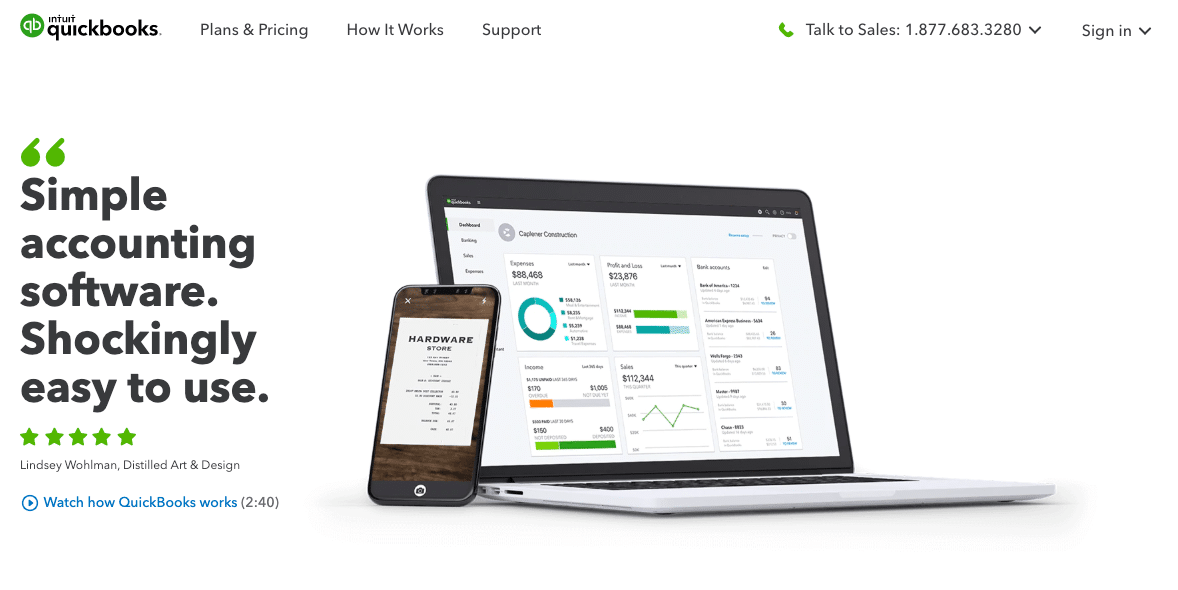
Quickbooks is a simple accounting solution that helps you organize your payments, expenses, and total revenue. It’s easy to use and provides you access to reports that visualize the exact financial situation of your business.
At Kinsta, we’ve transitioned to using QuickBooks for invoicing, as it supports batch invoicing, and it’s been easier to integrate via APIs.
37. When I Work

When I Work is an online employee scheduling software and time clock. It allows employers with remote workers in multiple states/countries to easily keep track of when everybody is working.
At Kinsta, we use it to help our customer support and emergency engineer teams collaborate on covering the necessary time slots. It simplifies our shift management process and cuts down on a lot of excess communication that we had in the past.
Design
Finally, we use a couple of SaaS products to design our content.
38. Iconfinder
Every good website needs good visuals, and that is where Iconfinder thrives. It currently has a database of over 3.9 million icons, consisting of over 60,000 sets.

We use Iconfinder for icons on both our website and the Kinsta blog. We source most of the featured images you see here on the blog and in our Knowledge Base articles from Iconfinder.
One of the best features of Iconfinder is that they provide you with all four formats, SVG, PNG, AI, and CSH. We typically prefer working with SVG because they are scalable to any resolution without losing any image quality.
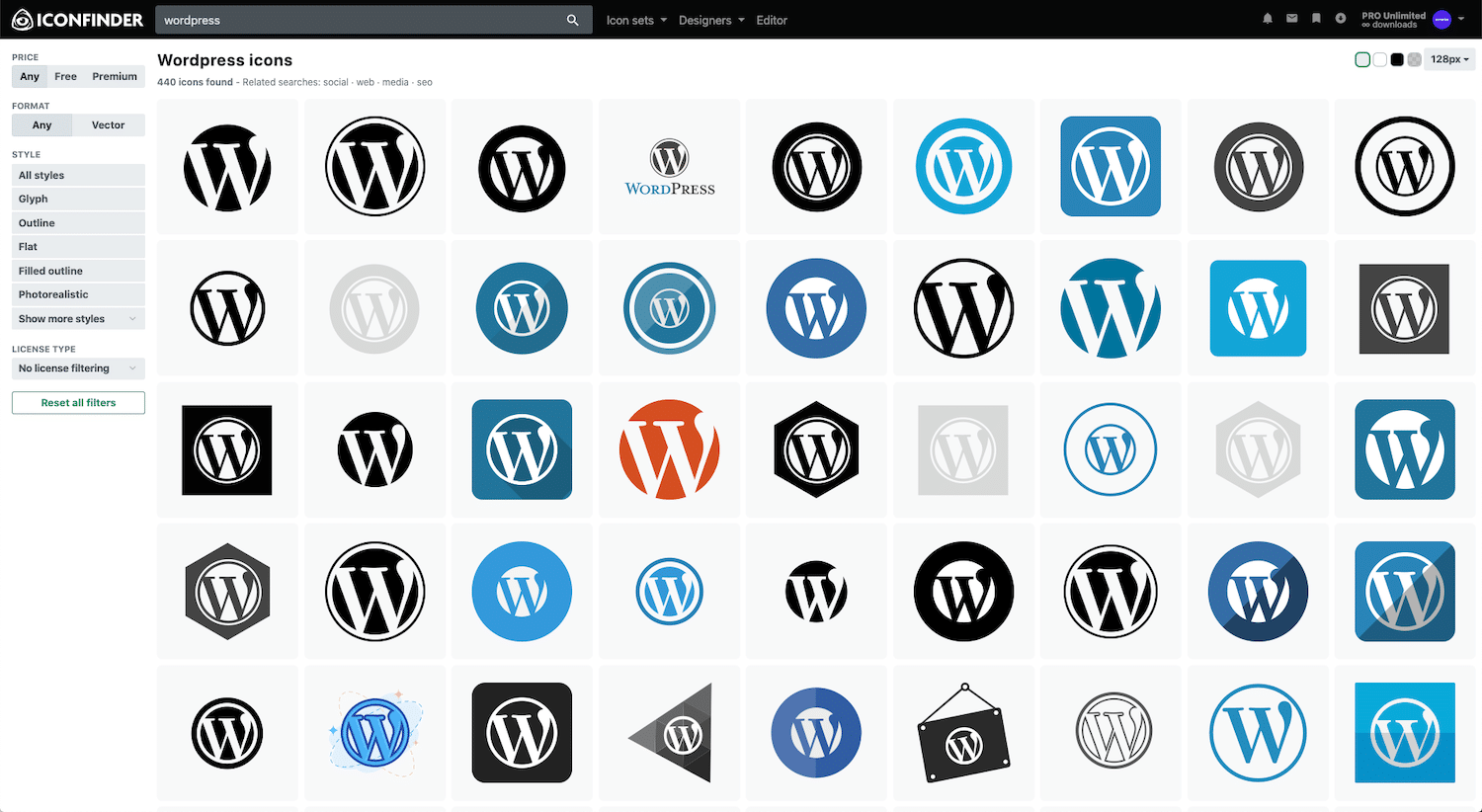
39. Canva
Canva is a web app that promises to help you “Design anything and publish anywhere.”
With a drag-and-drop interface, and much fewer options and tools than Photoshop, it’s easy to learn and use.
Even people who think they have no creative ability can use the existing templates to create blog graphics and social media ads that look great in just a few minutes.

At Kinsta, we use Canva to sketch graphics for our team of designers to finalize later. It helps speed up the process of visual design for content since there is less room for miscommunication.
Data Visualization
Since we handle copious amounts of data in providing our service, and in our marketing efforts, it can be hard to gain valuable insights by just looking at tables and numbers.
That’s why we use SaaS products for data visualization as well.
40. Kibana

Kibana is a data visualization tool for Elastic Stack that enables your team to visualize your ElasticSearch data.
In short, you can create and explore visual tables and reports that will give you unique insights. You can also deploy machine learning to figure out patterns that the human eye can’t spot.
At Kinsta, we use Kibana to make sense of the data in an easy-to-understand format.
Password Management
Worried about keeping track of the passwords for 40+ different SaaS products? You won’t have to with a password management solution.
41. 1Password
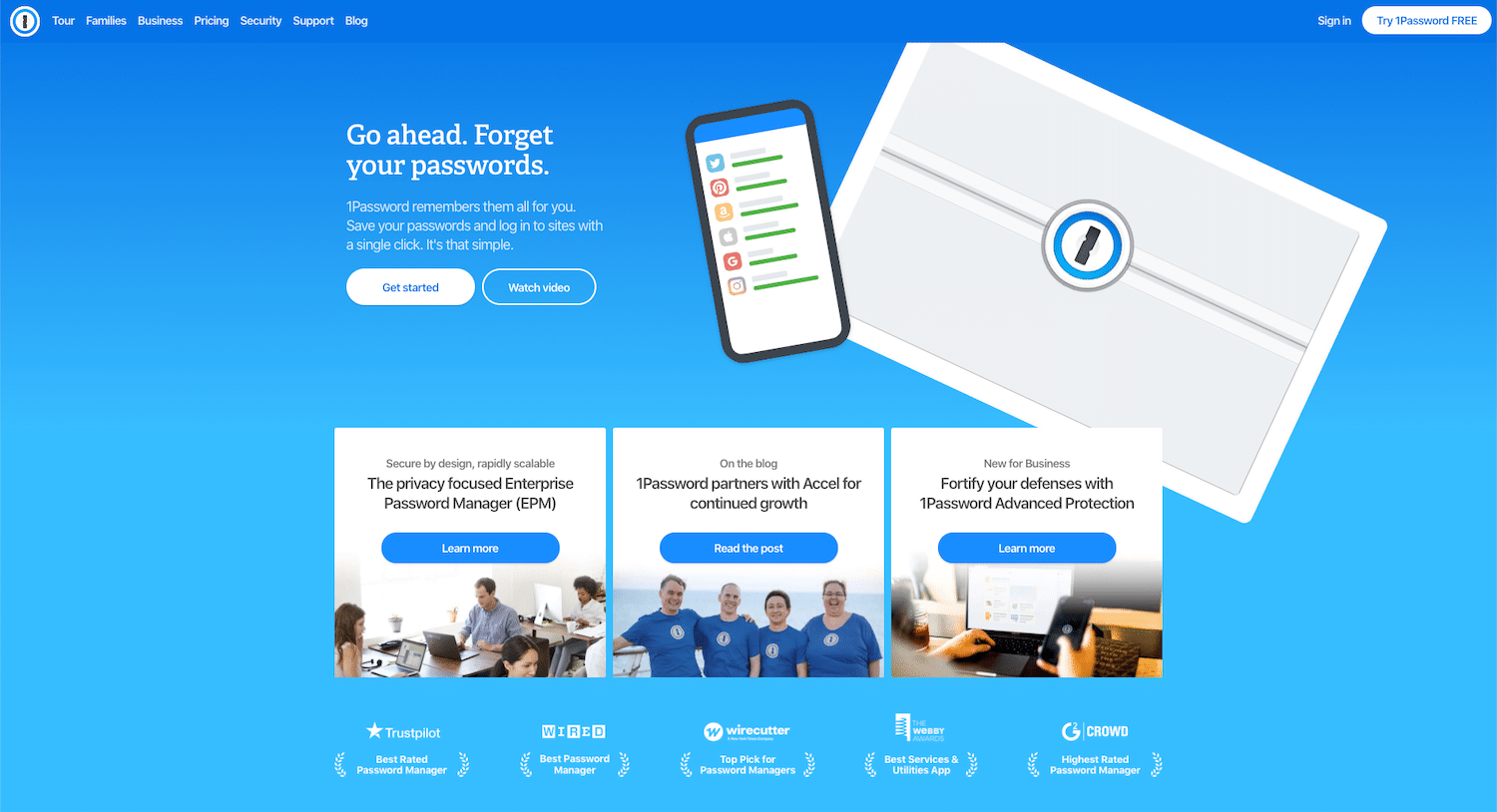
With 1Password, you can log in to all your company social media profiles and SaaS tools with just a single password. It really is that simple. No more costly minutes wasted resetting passwords by email every week.
At Kinsta, we use 1Password to ensure that everyone always has the access they need to the tools they use. It eliminates downtime and improves all our team’s efficiency.
Digital Signatures
Finally, we use a tool to handle digital signatures.
42. Digisigner
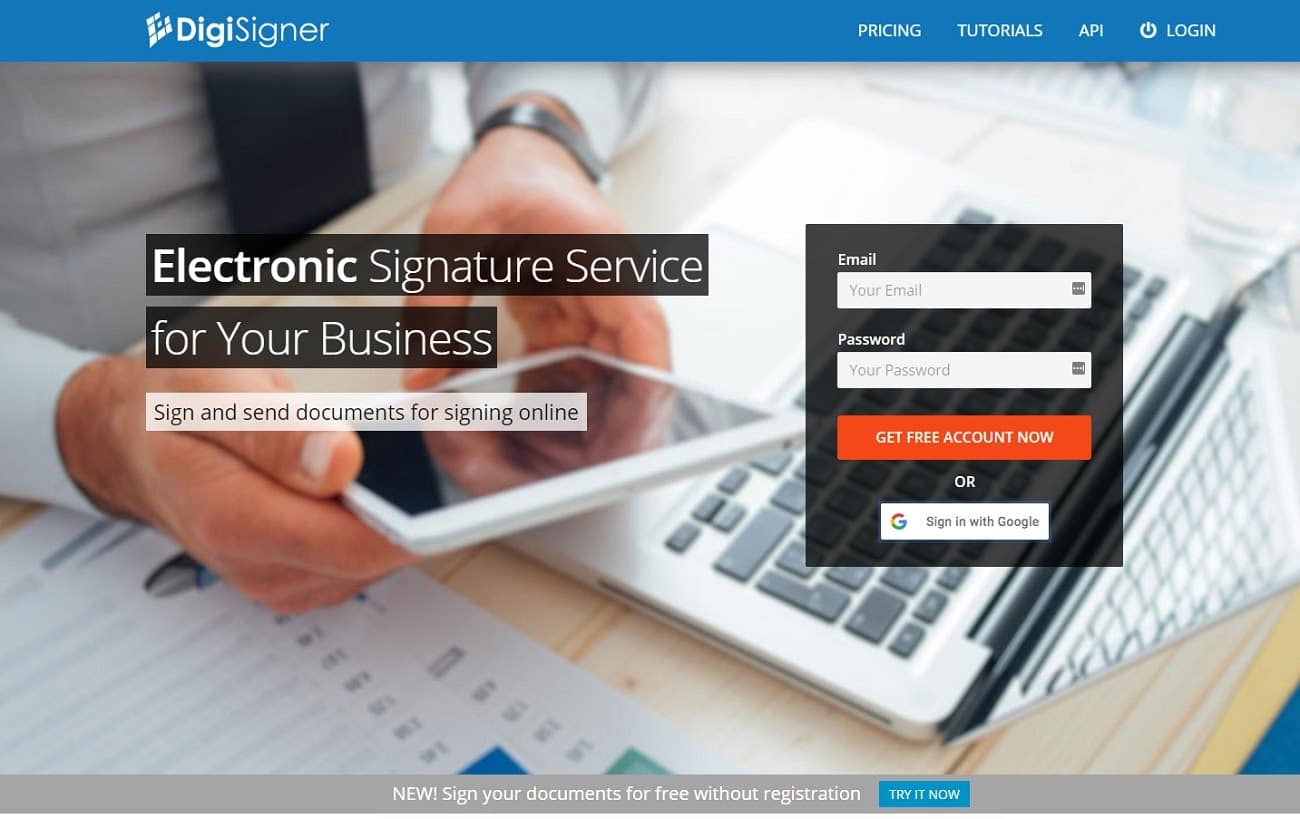
Digisigner is a free tool for receiving and leaving signatures on digital documents, like contracts in a PDF format sent by email.
At Kinsta, we use Digisigner to handle employee and freelancer contracts, considerably speeding up the hiring process. It also makes it easy to keep digital records of all our important documents.
Summary
As you can see, we use quite a few different SaaS products here at Kinsta, in all sorts of different areas. Each one of them serves a specific purpose and helps us be more productive and focus on what matters. And that is providing you with the best hosting experience possible!
Do you have any innovative SaaS products you currently use that you think we might like? If so, feel free to share them below.


